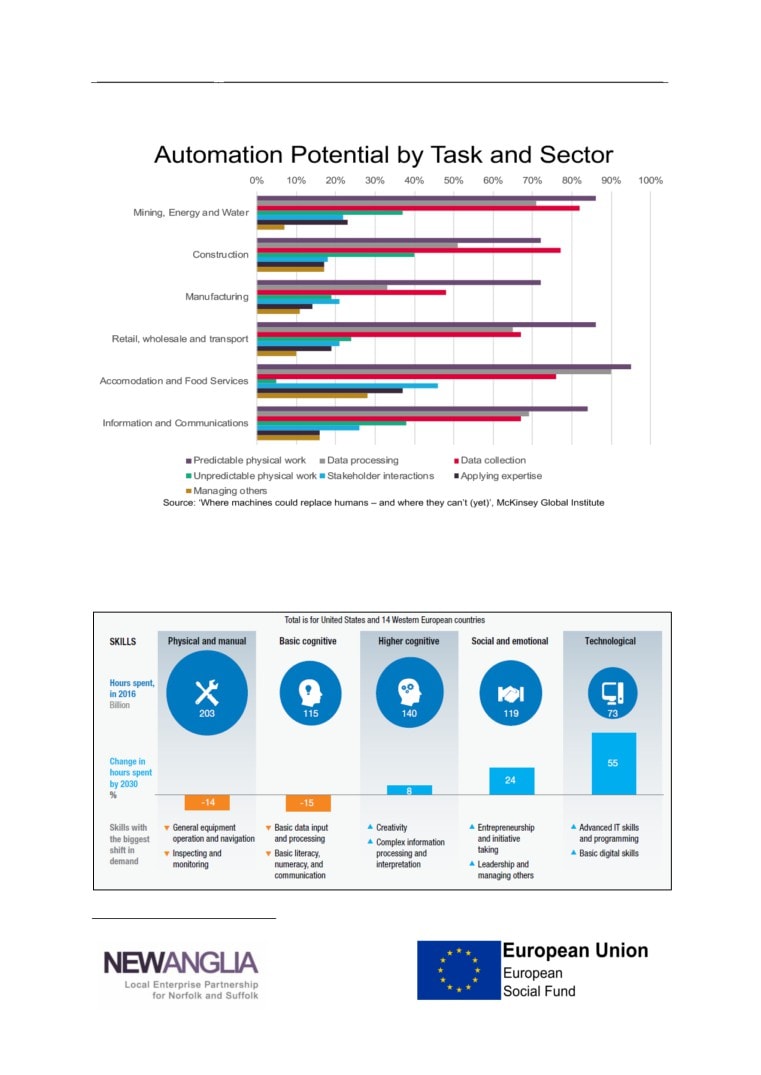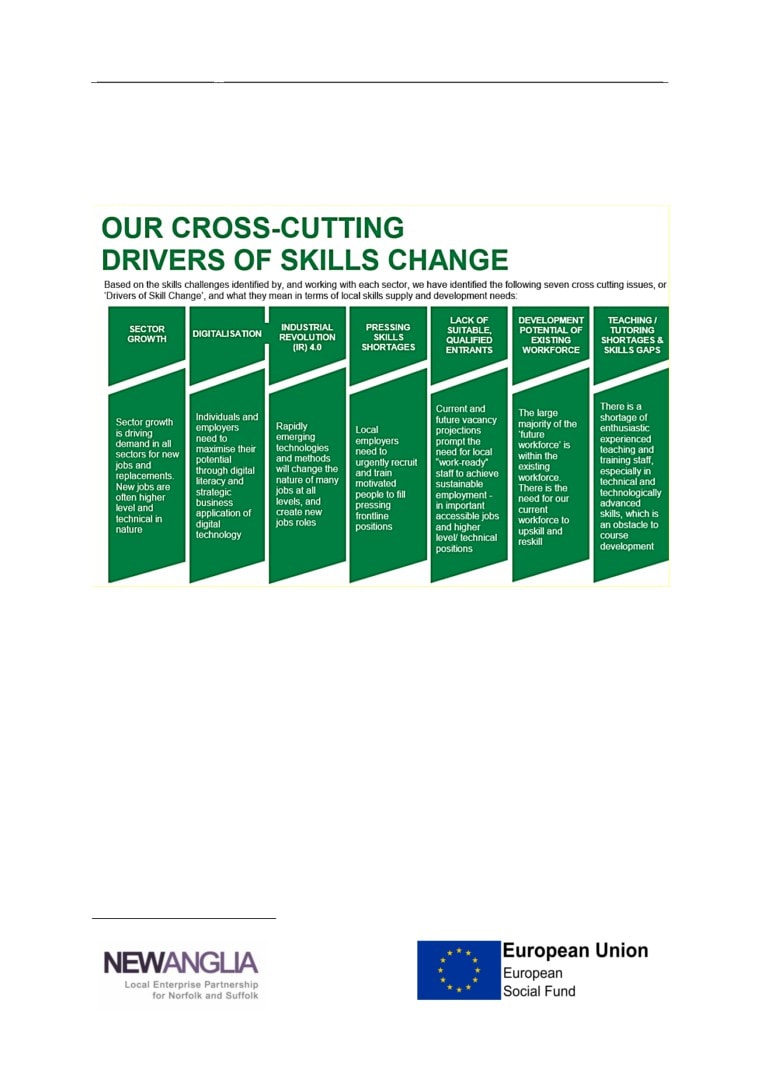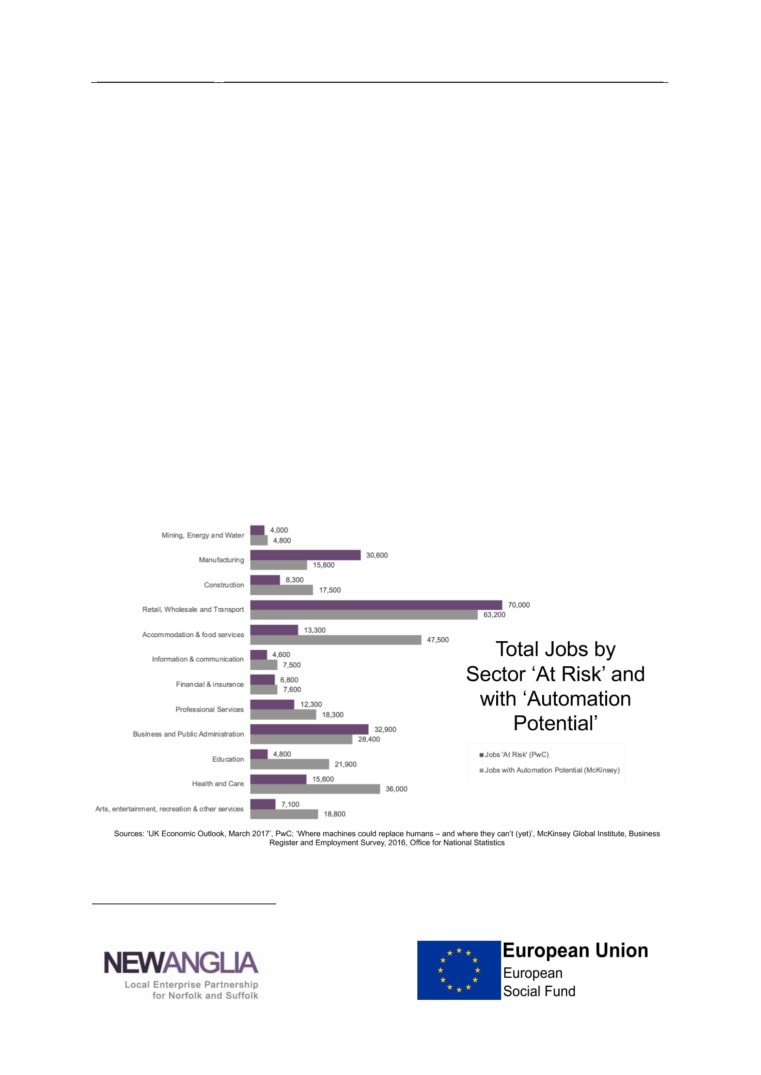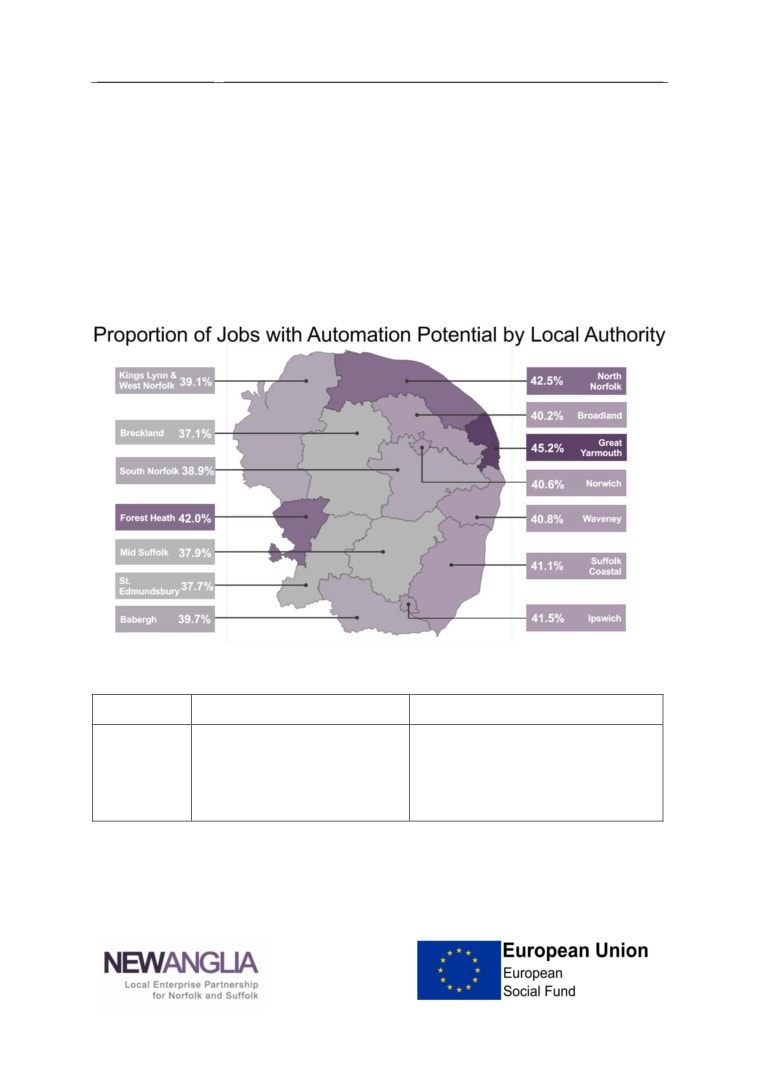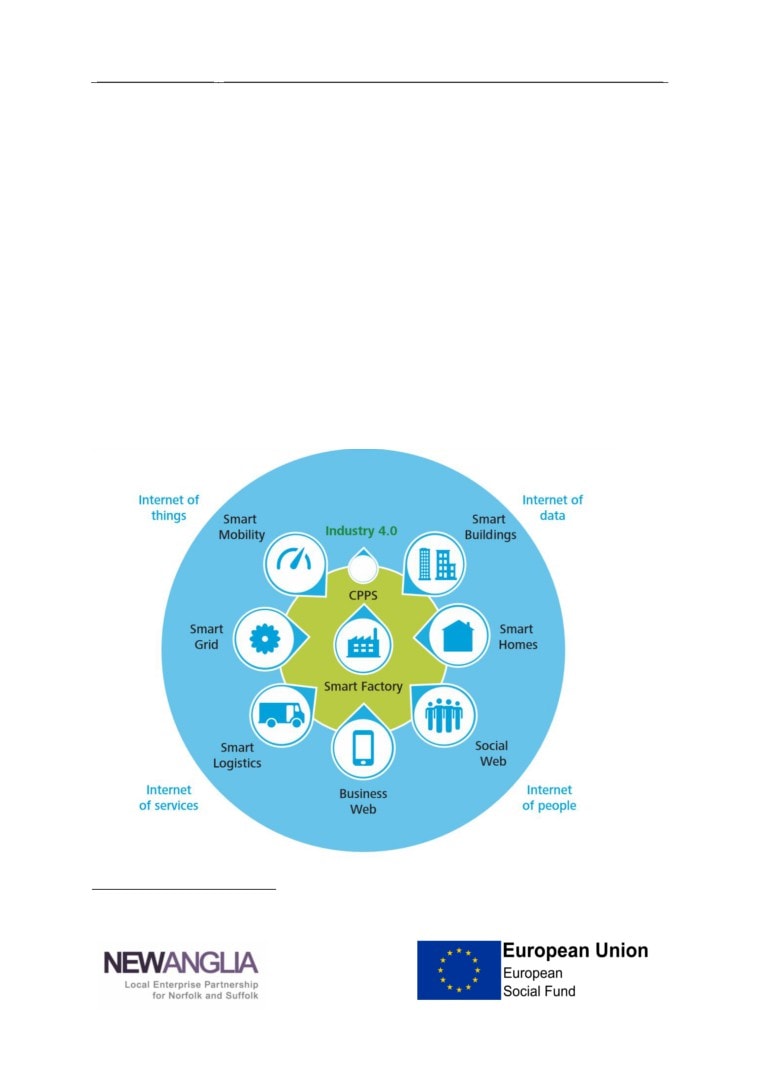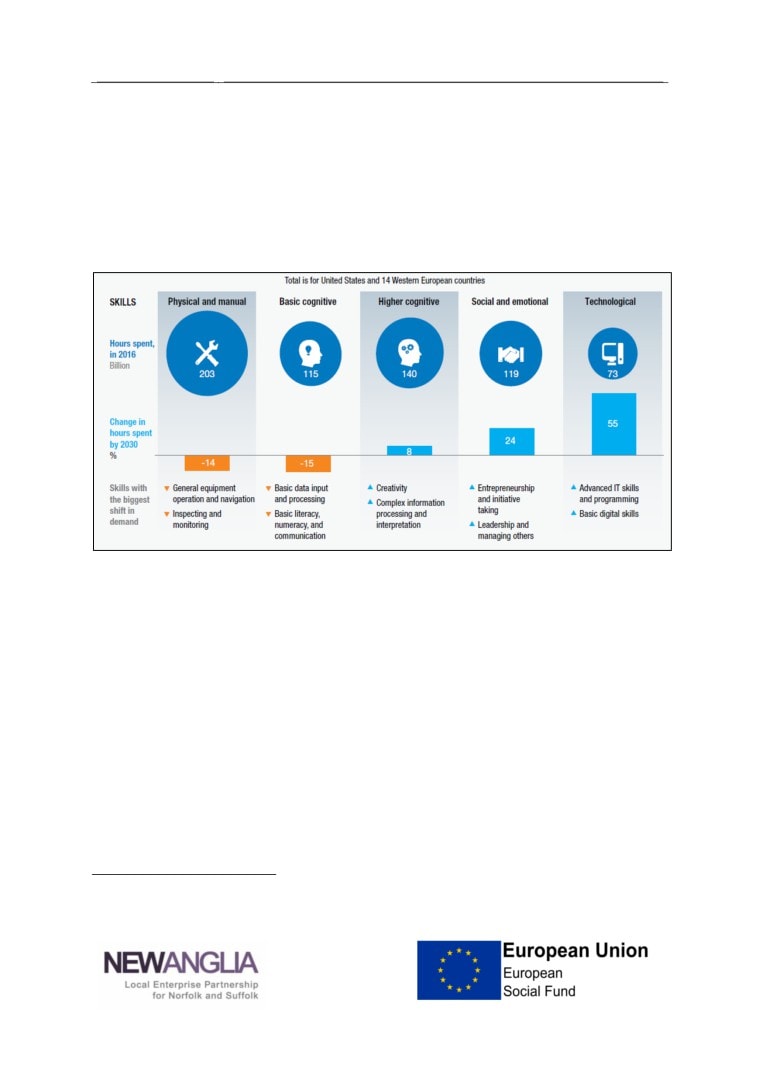New Anglia Emerging
Technology Skills Plan
2019
February 2019
New Anglia Skills Board version
‘We are stuck with technology when what we really want is
stuff that works’
In The Salmon of Doubt (2002 posthumous collection) by Douglas Adams (author of
the Hitchhikers Guide to the Galaxy and the Answer to Life, the Universe and
Everything)
emerging-tech-sector-skills-plan-skills-board-final-feb-19 (1)
Page 2
New Anglia LEP
Emerging Technology Sector Skills Plan, February 2019
Contents
Executive Summary
3
The Emerging Technology Sector Skills Plan
4
Context for Emerging Technology
5
Impact of Emerging Technology in New Anglia
9
Consultation Feedback
16
Emerging Technology Skills Plan
24
Skills Actions to be Taken
27
Action 1 - ICT and Digital in the Local Industrial Strategy
28
Action 2 - Train Young People to be Industry 4.0 Professionals
31
Action 3 - Upskill existing Industry 4.0 workforce
32
Action 4 - Integrate Industry 4.0 awareness into all courses at school/FE/HE
33
Action 5 - Upskill existing sectors workforce to adopt Industry 4.0
34
Annex 1 - Background to the Emerging Technology Challenge
35
What is Industry 4.0?
38
Impact across the Economy
39
The Evidence Base
42
International Reports
42
EU Report and Initiatives
46
National Reports
47
Regional Reports
53
Annex 2 - New Anglia Sector Skills Plans & the Adoption of Emerging Technology
54
Digital Tech
55
Life Sciences and the Bio-economy
55
Advanced Manufacturing and Engineering
56
Agri Food Tech
58
Energy
59
Ports and Logistics
59
Financial and Insurance Services
60
Cultural Sector
62
Skills Needs in Construction and Health and Social Care
63
Future work on Digital Creative and Education sectors
64
The Retail Sector
65
Annex 3 - Common Themes on Emerging Technology in the Sector Skills Plans
68
Annex 4 - Consultees
74
Page 3
New Anglia LEP
Emerging Technology Sector Skills Plan, February 2019
Executive Summary
The development of emerging technology or Industry 4.0, based on digital and
engineering technologies, is leading to major changes in large sectors of the
economy. The obvious example is retail and distribution, where online sales now
represents £1 in every £5 of the sector. Not surprisingly we are seeing jobs
displaced from the traditional retail sector and many established retail companies
failing whilst new online only companies emerge.
Reports suggest that 30% of current job roles in New Anglia, could be lost or change
fundamentally and many more will need new skills as digitalisation and automation
impactson both public and private sectors. Allaying fears, the rebalancing of jobs
towards higher skills presents a real opportunity for upskilling and lifelong learning.
However, the Industry 4.0 revolution is occurring at a time of historically low
unemployment, with the dependency ratio rising and most employers struggling to
secure the workforce needed. The local economy will also be able to expand if it is
nationally and internationally competitive. If New Anglia is World class in its adoption
of Industry 4.0, the productivity benefits this brings will lead to economic growth,
more higher paid, higher skilled jobs and enough jobs for everyone.
The technology supply sector is anticipated to grow as the demand for Industry 4.0
solutions grow offsetting some of the jobs displaced in other sectors. Job creation
will though not be limited to the technology sector, with new jobs and job roles
created right across the economy as Industry 4.0 facilitates the creation of new
products and services, improves competitiveness and enables new job roles.
Skills is an essential enabler of this transition. Whilst new skills will be needed in the
companies supplying Industry 4.0 solutions, in terms of scale, the bigger opportunity
is in ensuring that the 90%+ of the economy which is an end user of Industry 4.0
technologies has the skills to be expert in using Industry 4.0 to increase productivity.
The scale and speed with which job roles will change means that the transition to
Industry 4.0 will require a substantial increase in retraining for the existing workforce.
Given the focus in the New Anglia Local Industrial Strategy on digitalisation,
addressing the implications of Industry 4.0 should be a strategic priority for the LEP.
Action is needed in 4 main areas to deliver on the potential of Industry 4.0:
• Increasing student supply into the technology sector with Industry 4.0 skills;
• Upskilling the technology workforce to spearhead adoption of Industry 4.0;
• Ensuring all students, regardless of sector, have Industry 4.0 in their courses;
• Upskilling and retraining the existing workforce in end user sectors for new or
changed job roles enabled by Industry 4.0.
Page 4
New Anglia LEP
Emerging Technology Sector Skills Plan, February 2019
The Emerging Technology Sector Skills Plan
The Emerging Technology Sector Skills Plan has been developed by Norfolk and
Suffolk, working alongside the New Anglia Local Enterprise Partnership, the New
Anglia Skills Board and supported by SkillsReach.
SkillsReach was contracted to facilitate and prepare sector skills plans for the New
Anglia LEP priority sectors. The project was commissioned by the Education and
Skills Funding Agency, in partnership with New Anglia LEP, and funded through the
European Social Fund. Each Sector Skills plan and supporting Data Pack has been
developed in collaboration with local employers and other stakeholders.
The New Anglia Skills Board places employers at the centre of decision making on
skills in Norfolk and Suffolk to ensure the skills system becomes more responsive to
the needs of employers, and the future economy.
Whilst there is currently not a formal industry led sector group for Emerging
Technologies which covers the whole of New Anglia, there are a range of bodies
such as the Institute of Productivity (IoP) and proposed Eastern Institute of
Technology (EIoT), which focus on and represent the stakeholder community.
SkillsReach is an established East of England-based strategic skills consultancy with
an associate project team with extensive experience of developing skills plans.
Acknowledgements
The New Anglia LEP wish to thank the employers, training providers and
stakeholders who contributed to the plan by attending events, being interviewed or
by making referrals to employers and organisations in the sector. This sector skills
plan was developed in 2018 by SkillsReach.
Page 5
New Anglia LEP
Emerging Technology Sector Skills Plan, February 2019
Context for Emerging Technology
The World Economic Forum report in 2018 on the Future of Jobs1 states that:
The Fourth Industrial Revolution is interacting with other socio-economic and
demographic factors to create a perfect storm of business model change in all
industries, resulting in major disruptions to labour markets. New categories of jobs
will emerge, partly or wholly displacing others. The skill sets required in both old and
new occupations will change in most industries and transform how and where people
work. It may also affect female and male workers differently and transform the
dynamics of the industry gender gap.
The Fourth Industrial Revolution is being driven by Emerging Technology and in its
breadth and speed is creating a rapid change in the skills needed right across the
economy.
This skills plan is therefore different to the other Sector Skills Plans developed by
New Anglia during 2016-’19, because it has to cover the whole economy. This need
to focus on emerging technology and Industry 4.0 was clearly evident in the New
Anglia Cross Cutting report (summer 2018) which reviewed the common themes
which were emerging from the individual New Anglia sector skills reports.
The Fourth Industrial Revolution is also called Industry 4.0 and many descriptions
also uses terms such as the Internet of Things or the Internets of Data, Systems and
People - in practice it is all of these and is the transition in the economy facilitated by
the merging of the physical and digital environments.
The results are potentially very large for the economy with reports suggesting that:
•
15-30% of jobs could be displaced completely within the next decade;
• And, the nature of the roles in a further 30-40% of jobs may change substantially;
• New roles will also be created as all employers (public and private) utilise
emerging technology to offer new or enhanced products and services.
Applying analysis by PWC (2017) to assess which jobs are at risk due to Industry 4.0
suggests that over 303,000 jobs in New Anglia could be displaced, with similar
analysis by McKinsey (2016) on jobs which have potential for automation suggesting
that 287,000 jobs in New Anglia could be affected by automation (see figure 1). The
magnitude of this change, by 2030, clearly shows the scale of potential impact.
1 World Economic Forum (2018), Insight Report: The Future of Jobs Report 2018, Centre for the New Economy
and Society
Page 6
New Anglia LEP
Emerging Technology Sector Skills Plan, February 2019
Figure 1 - Automation Potential by Task & Sector of the New Anglia Economy
The difference in the impact on different types of skills is also illustrated by other
work2 which shows big anticipate changes in the balance of skills needed:
Figure 2: Changes in the balance of skills needed
2 McKinsey Global Institute (2018), Skill Shift Automation and the Future of the Workforce
Page 7
New Anglia LEP
Emerging Technology Sector Skills Plan, February 2019
In responding to Industry 4.0 the region will obviously require new skills in
technology supply companies, but the larger effect in terms of the numbers of people
impacted will be in those sectors which use technology (in both the public and
private sectors).
This is because these end user sectors are physically much larger and have more
job roles which are at risk or will change due to automation and Industry 4.0. Whilst
this is a challenge for initial training, the larger need will be for new skills amongst
the existing workforce if we are to help the established workforce adapt to these
changes.
Process to Develop the Plan
The process to develop the Emerging Technology Sector Skills Plan has involved:
• Drawing on other New Anglia Sector Skills plans;
• Reviewing reports on emerging technology from local to global level;
• Developing data to explore the impact of emerging technology on job roles and
the workforce at aggregate and sectoral levels;
• Attendance at and running meetings and events to consult with stakeholders on
the way in which emerging technology will impact workforce and skills issues.
New Anglia Sector Skills plans
Over the last 2 years New Anglia has developed 10 sector skills plans:
•
2 in 2016 (in house) which looked at: Construction; Health and Social Care.
•
8 during 2017-18, led by SkillsReach, which looked at: AgriFood Tech; Digital
Tech; Advanced Manufacturing & Engineering; Financial & Insurance Services;
Energy; Life Sciences & the Bio-economy; Ports & Logistics; Cultural Sector.
• A further 2 (in addition to this plan) are currently in development.
Details of the way in which each of these plans approached emerging technology
and the key conclusions in each plan in relation to this challenge are set out in
Annex 2.
In addition to the individual sector skills plans, in summer 2018, SkillsReach also
developed a cross cutting report which brought together common issues from across
all the individual sector skills plans. This process clearly identified emerging
technology as a cross cutting theme (figure 3):
• Both as a challenge in its own right - Industrial Revolution 4.0;
Page 8
New Anglia LEP
Emerging Technology Sector Skills Plan, February 2019
• And also through the pervasive nature of digitalisation of the economy and thus
workforce skills, which is a key enabler and driver of the fourth Industrial
Revolution, or Industry 4.0.
Figure 3 - Drivers of Skills Change, New Anglia Cross Cutting Report 2018
(Source: New Anglia Sector Skills Plans Cross Cutting Report, 2018)
This same approach, with Industrial Revolution 4.0 (or Industry 4.0) as both a
challenge in its own right and as a driver of change across the economy, was also
recognised in the Made Smarter Review (originally known as the Industrial
Digitalisation Review or IDR) published by the UK government in November 2017.
Accenture led this national work which concluded that investing in digitalisation could
be worth £455bn to the UK economy over a decade3.
Reports on emerging technology from local to global level
This plan also reviews a wide range of reports from regional to global level which
have looked at how new, digitally enabled, technologies and Industry 4.0 will impact
on job roles and the workforce. Annex 1 includes highlights from these reports.
3 HMG (2017), Made Smarter Review
Page 9
New Anglia LEP
Emerging Technology Sector Skills Plan, February 2019
Impact of Emerging Technology in New Anglia
Data on job roles and potential impacts
In parallel to the consultations and review of reports undertaken, SkillsReach have
mapped the impact that the expected change in job roles created by Emerging
Technology will have on the workforce at aggregate and sectoral levels in Norfolk
and Suffolk (at both district and LEP levels).
The data is presented in full in a separate datapack, which supports this sector skills
plan.
The key conclusions drawn from these assessments, which draw on global and UK
research by McKinsey Global Institute (2016)4 and PWC (2017)5, suggests that the
New Anglia economy is as exposed as any region to the changes which Industry 4.0
and Emerging Technology will mean for the economy, employers and workers
themselves (see figure 4)
Figure 4 - Total Jobs by Sector ‘At Risk’ (PWC) or with ‘Automation Potential’
(McKinsey)
4 McKinsey Global Institute (2016), Where machines could replace humans - and where they can’t (yet)
5 PWC (2017), UK Economic Outlook, March 2017
Page 10
New Anglia LEP
Emerging Technology Sector Skills Plan, February 2019
The main impacts are likely to be:
• Employees with lower levels of qualifications are more at risk of seeing their job
automated - 46% of those with only GCSE or below levels qualification are at
risk, compared to only 12% of those with degree level qualifications (see table 1);
Table 1 - New Anglia workforce ‘At Risk’ of Automation by Qualification Level
(see datapack for full details and referencing)
Higher
% with degree or equivalent & above - aged 16-64
221,300
Education
Number at Risk
26,600
(12% at Risk)
% with higher education below degree level - 16-64
73,800
% with GCE A level or equivalent - 16-64
247,600
Medium
% with GCSE grades A-C or equivalent - 16-64
222,100
Education
(36% at Risk)
Total
543,500
Number at Risk
195,700
% with other qualifications (GCSE) - 16-64
99,500
Low
% with no qualifications (GCSE) - 16-64
77,400
Education
Total
176,900
(46% at Risk)
Number at Risk
81,400
Total at Risk
303,600
Population Aged 16-64
941,700
Totals
% at Risk
32%
•
15-30% of jobs could be displaced completely within the next decade by new
technology which automates a role entirely making it redundant, but with large
variation between sectors (see table 2);
• The nature of the job roles which need to be undertaken in a further 30-40% of
jobs may change substantially, necessitating these staff to develop new skills
(see table 3);
Page 11
New Anglia LEP
Emerging Technology Sector Skills Plan, February 2019
Table 2 - Analysis of Key Determinants of Job Numbers at risk by sector (see
datapack for full details and referencing)
Highest impact
Lowest impact
Number of
70,000 jobs have automation
4,800 jobs have automation
job roles at
potential (McKinsey) &
potential (McKinsey) & 4,000
risk by
63,200 (PWC) are at risk in
(PWC) are at risk in mining, energy
sector
retail, wholesale & transport
& water
The sector with the highest
The sectors with the lowest
proportion of automation
proportion of automation potential
potential (McKinsey) is
(McKinsey) are manufacturing with
accommodation & food
30% and business & public
service with 75%
administration with 31%
Table 3 - Analysis of Key Determinants of % of Job at risk by sector (see
datapack for full details and referencing)
Highest impact
Lowest impact
Sector
46% jobs in manufacturing at
8.5% jobs in education sector at
risk (McKinsey 2016)
risk (PWC 2017)
The impact on sectors varies due to:
• Substantial difference in terms of the numbers of job roles at risk, based on both
the proportion of job roles in the sector at risk and large variations in employment
by sector. The largest impacts are likely in sectors with a large workforce, many
of whom do repetitive roles.
• Using PWC analysis 3 sectors account for 63.5% of all jobs at risk:
o Retail, wholesale & transport at 70,000 jobs;
o Business & public administration at 32,900 jobs;
o Manufacturing at 30,600 jobs.
• In contrast other sectors are likely to see many fewer staff displaced as they are
smaller employment sectors with a smaller % of job roles at risk of automation.
• In some sectors there is a big gap between jobs at risk (PWC analysis) and those
where the job role may change due to automation of some roles which are
currently performed by people (McKinsey analysis) e.g. health and social care,
accommodation and food service.
The conclusion is that there is a large degree of variation between sectors of the
economy in terms of what proportion of jobs are at risk. As a generalisation sectors
Page 12
New Anglia LEP
Emerging Technology Sector Skills Plan, February 2019
which have more jobs roles which require problem solving, creativity & inter-personal
skills have less potential for automation than those where repetitive, manual tasks &
routine data recording or input are required.
Furthermore:
• New job roles will be created as all employers (public and private) utilise
emerging technology to offer new or enhanced products and services, but many
of these new roles are not yet apparent and so are hard to plan for;
• Industry 4.0 will require new skills in technology supply companies, whose market
is likely to grow necessitating the recruitment of extra staff as well as the
development of new skills;
• Overall, the changes expected will have a larger effect in terms of the numbers of
people impacted in those sectors which use technology (in both the public and
private sectors), with most sectors seeing half or more of their current job roles
either displaced completely or substantially changed by technology;
• The speed of change also means that we cannot be focused just on young
people entering the workforce for the first time. To respond positively to Industry
4.0 will require a significant increase in upskilling of the existing workforce.
The data analysis therefore shows that the impact of Emerging Technology will be
felt right across the economy and across all districts in New Anglia.
Every sector will be affected, with some sectors which have not been seen as
priorities by New Anglia e.g. retail and public and business administration, seeing
some of the biggest anticipated changes in terms of the number of job roles which
are at risk.
In the case of retail, the development of online retailing and the displacement of high
street stores means that the largest private sector employer in New Anglia, the retail,
wholesale and transport sector, is likely to see a rapid displacement of workers (see
annex 2 for further analysis of this).
Page 13
New Anglia LEP
Emerging Technology Sector Skills Plan, February 2019
Spatial Impact
The variation between districts in terms of the % of jobs with automation potential is
relatively low, suggesting that all districts will be impacted to a medium to large
extent (figure 5).
The district level variation is primarily driven by variations in the sectors which
predominate in the local economy at district level (table 4).
Figure 5 - Proportion of Jobs with Automation Potential by Norfolk and Suffolk
Local Authority
Table 4 - Districts level impact (see datapack for full details and referencing)
Highest impact
Lowest impact
District
Proportion of jobs roles with
Proportion of jobs with automation
automation potential is
potential is lowest at 37.1% in
highest at 45.2% in Great
Breckland
Yarmouth
Page 14
New Anglia LEP
Emerging Technology Sector Skills Plan, February 2019
The potential for economic gain
However, reports also suggest that, in common with previous Industrial Revolutions
the changes we are likely to see due to Industry 4.0 will also:
• Increase growth;
• Create new industries and job roles, many of which don’t currently exist.
The Made Smarter Review (2017), as noted above, projects that embracing Industry
4.0 will unlock growth across the economy, worth £455billion in the first decade.
Other reports make similar projections with a recent report from BEIS (2019) on
Artificial Intelligence (AI)6 reporting on work by Accenture which suggests that AI
could add £630billion to the UK economy by 2035 and increase GVA growth from
2.5% to 3.9% (much higher than has been seen in the last 20 years).
Furthermore, wider changes in the economy and demographics mean that young
people entering the jobs market and those displaced from existing roles are likely to
find jobs, because:
• In New Anglia and the UK, over the long term birth rates have fallen meaning that
there are fewer young people entering the workforce;
• Average age in the workforce is increasing and many industries are struggling to
find enough young entrants to replace those who retire;
• Unemployment rates have fallen and are now at the lowest rates since the early
1970s meaning that there is very little slack in the jobs market.
The real economic challenges are therefore that:
• The economy needs to address wage growth which lagged inflation for nearly a
decade after the economic crash in 2007-’08, with a squeeze on family incomes
and growing political impacts as workers saw the value of their earnings eroded
by inflation for the longest period in at least 70 years;
• The dependency ratio is rising (i.e. how many people each worker supports),
meaning that the economy needs to increase the productivity generated by each
worker so they can support more of those who are not working (whether as
children, students or the retired);
• Workforce supply is the growing challenge for most employers.
6 Professor Dame Wendy Hall and Jérôme Pesenti (2019), Growing the Artificial Intelligence Industry in the
UK, BEIS
Page 15
New Anglia LEP
Emerging Technology Sector Skills Plan, February 2019
Productivity growth is therefore needed to increase wealth and real wages through
creating higher paid, higher skilled jobs which are more productive.
This analysis suggests that even if 30% or more of current job roles are lost to
digitalisation & automation (as some suggest), we will not be short of jobs.
Those displaced will find new jobs, in new industries or by undertaking new roles in
their current industry or for their current employer. However, Industry 4.0 is, like
other industrial revolutions, likely to change the structure of the economy across the
country and indeed the World.
No LEP area is immune from this change and whether this change allows an area to
improve its position will primarily depend on the speed with which it is able to
respond.
A critical determinant of whether an employer, sector, LEP area or the whole of the
UK is able to benefit from the potential productivity gains created by Industry 4.0 will
be its ability to ensure that it has the skills and knowledge to embrace this change.
This must encompass both ensuring the young have the skills needed to prosper in
the new working environment and that the existing workforce is supported to gain the
skills needed for new or changed job roles.
In a new paper McKinsey7 argues that we have to embrace lifelong employability by
changing the way that we train workers for new roles. The key need they identify is
to support existing workers to gain the new skills needed through tailored, bite sized,
regular, participatory and social learning, which becomes a standard part of
organisational culture, rather than formal, standardised and occasional courses.
They argue that unless this change is embraced workers will find it increasingly
difficult to keep up to date with the skills needed in the workplace as it embraces
technology, with artificial intelligence (AI) being particularly disruptive to job roles.
7 McKinsey (2019), Competitive Advantage with a Human Dimension: from Lifelong Learning to Lifelong
Employability
Page 16
New Anglia LEP
Emerging Technology Sector Skills Plan, February 2019
Consultation Feedback
Meetings and Events
In developing the Emerging Technology Skills Plan a number of local, regional,
national and international meetings were attended to provide feedback on how
different sectors, stakeholders and regions see this challenge. This included:
• Liaising with providers and stakeholders in the Institute of Technology (IoT)
(meetings in July and September 2018) & Institute of Productivity (IoP)
development group (meeting October 2018) to understand how these initiatives
can support New Anglia in responding to the Emerging Technology challenge;
• Engaging with employer stakeholders to understand how the challenge paper
conclusions relate to their experience through consultations at:
• The 17th September 2018 productivity challenge event run by Hethel
Innovation at UEA;
• The 16th November 2018 employers engagement event run to support the
Eastern Institute of Technology (EIoT) proposal.
The plan was also be informed by feedback gained by Martin Collison (SkillsReach
team) from engaging with a range of regional, national and international events
focused on Industry 4.0 and digital technology adoption, including (all funded
separately to the skills plan):
• Speaking to the Lincolnshire Industry 4.0 skills working group 30th August 2018;
• Speaking at the Agricultural Economics in Transition conference XV in Budapest
on how technology will change the food chain 11th September 2018;
• Attending the Greater Lincolnshire Innovation Council meeting on Industry 4.0 on
19th September 2018;
• Speaking at the EU SKIN Project technology event in Hungary on 25th
September 2018;
• Speaking at the EFFAT EU Trade Union’s events: Budapest on 25th October
2018; Copenhagen on 5th February 2019, on technology impacts on job roles;
• Speaking at the West Sussex Growers Association in Chichester on 26th October
2018 on how technology will affect the agricultural and horticultural industry;
• Presenting the draft plan to the New Anglia Innovation Board on 19th February
2019 to debate how best the region can rise to the challenge of Industry 4.0.
Page 17
New Anglia LEP
Emerging Technology Sector Skills Plan, February 2019
Employer Consultee Feedback
Employer representatives at the EIoT meeting reported that many people and
organisations are still not clear what is meant by Industry 4.0, or how this will impact
their workplace and thus are uncertain how skills needs are likely to change.
It was reported that some major sectors, e.g. construction, know that Industry 4.0 will
impact them, but very few in this sector have begun to address this challenge to
date, largely due to more pressing short term issues and a lack of certainty about
how it may impact them.
A straw poll of 12 employers at the consultation exercise for the Eastern Institute of
Technology (EIoT) showed that on a scale of 1-5 (where 1 = not ready and 5 =
ready):
• For employers who were primarily technology end users (7 companies): the
average score for their organisation’s preparedness for Industry 4.0 was 2.7
compared to 2.4 for their sector as a whole;
• For purely technology provider companies (1 company) they rated their own
company at 5, but their sector still only at 1;
• For companies which both provide and buy technology (4 companies), the rating
was 3.8 for their own readiness but only 2.0 for their sector as a whole.
This is broadly consistent with other reports and surveys, which show that many
companies and employees rate their own preparedness for Industry 4.0 more highly
than the sector in which they work.
In August 2018 the Fabian Society and Trade Unions launched a 2 year commission
into Workers and Technology8, with the publication of new evidence on British
workers hopes and fears for automation in the next decade. Their initial evidence
shows that (based on an online survey of over 1,000 workers):
• Overwhelmingly, workers are positive about their own ability to navigate change:
73% are confident they will be able to change and update their skills if new
technology affects their job. After learning about how technological changes will
affect the workplace, over half (53%) were optimistic about their future working
life and job prospects.
• However, a significant minority were anxious about the impact of automation over
the next 10 years: 37% of workers (i.e. circa 10 million people nationally) are
Page 18
New Anglia LEP
Emerging Technology Sector Skills Plan, February 2019
worried their job will change for the worse; and 23% of workers (i.e. 6
million people) are worried that their current job may no longer be needed.
Whilst the balance of those consulted were optimistic about their own chances of
coping with the changes brought about by Industry 4.0, this contrasted sharply with
their views about the help on offer to them to help them embrace Industry 4.0:
•
9% of workers think that the UK government is taking steps to prepare them for
new workplace technologies;
•
16% (with a trade union in their workplace) think their union is taking steps to
help ensure new technologies improve working life;
• And, only 27% think their employer is taking action to prepare them for change.
Caution is needed in interpreting this data, because those who are more likely to
respond to these surveys are usually those who have already engaged with the
issues and are thus likely to be more prepared.
However, the local evidence and national reports consistently suggest that, at
sectoral or economy level, many employers have yet to understand the impact that
Emerging Technology may have on their organisation.
What Action is Needed
Key areas which local employer and stakeholder consultees considered the region
needs to focus on to provide the skills needed for emerging technology were:
• Apprenticeships - there was concern that the levy and reforms have disrupted
established successful models in the technology sector. There is a need for
apprenticeships to have more status and for greater flexibility in how
apprenticeships are managed. Employers felt that the frameworks and standards
were too rigid and not flexible enough to meet the rapidly changing employer
needs which Industry 4.0 implies;
• Applied courses - degrees need to be more applied e.g. including placements, so
that students are prepared for the way in which emerging technologies can be
applied. Employers also favour ‘HNC’9 type provision and think this should be
used to address the emerging technology skills need;
• Work experience - it was felt strongly that current work experience is failing
young people and that children, from age 14, should be supported to use their
holiday time to gain experience of work (employers stressed that the excuse that
this is stopped by H&S can be overcome with the correct risk assessments even
9 Employers favoured part time, practically applied provision which employees can combine with work and
which are delivered on a block or day release basis with further practical study in the workplace
Page 19
New Anglia LEP
Emerging Technology Sector Skills Plan, February 2019
in very physical environments such as construction). This work experience should
be accredited;
•
Vocational pathways - there is a need for a vocational pathway at GCSE. It was
felt that ‘T’ Levels are too late as by this stage most students are fixed on an
academic route even if this does not suit them;
•
Young workers as trainers - employers reported that many young staff in their
organisation had a much better understanding of the potential of emerging
technology and could be used to train older staff in how to optimise the use of
new technology;
•
Local delivery - employers stressed that local delivery is essential because many
students and workers will not/cannot travel easily across the region. To deliver
new skills for Emerging Technology it will therefore be important to include virtual
outreach, blended learning (so that learners get a social experience as well) and
similar models (e.g. video conferencing), so that the whole workforce can
participate at a time and pace which suits them and their other commitments;
•
Bite size delivery is also needed for industry 4.0 using videos, practical
applications and test centres, with this particularly important for the established
workforce who need to fit training in around their other commitments;
•
Culture change - it was felt that the biggest challenges to adopting Industry 4.0
relate to culture change and thus a focus on soft skills is needed alongside
technical education and training to support business uptake.
Delivery also needs to recognise that:
• Working through established business groups can be very effective - many
business groups have HR manager forums/groups which can be used as an
effective conduit to promote training and to ensure that regional programmes
align with employers’ internal programmes;
• Need to reduce the bureaucracy - if businesses are expected to manage the
process this is likely to fail, because the administration of publicly supported
training is simply too complex (including apprenticeships) and, if businesses are
expected to do this themselves, many will not take part.
It was felt that the most important issue for employers is to get rid of educational
jargon and produce a simple, clear 2 page explanation of the emerging technology
training offer, which ends with a very clear set of next steps which they can take to
engage in the process. It was felt that unless this is implemented most businesses
will not choose to engage and will continue to try to meet their needs through
recruitment rather than training their own staff.
Page 20
New Anglia LEP
Emerging Technology Sector Skills Plan, February 2019
Strategic Alignment
Consultees at the New Anglia Innovation Board suggested that:
•
There is a need to co-ordinate local action being taken on Industry 4.0 related
provision by the Institute of Productivity (IoP) at UEA with the Institute of
Technology (subject to approval);
•
The review of Post-18 Education10 led by Philip Augar is important in reviewing
both FE and HE provision and how this can provide seamless progression, which
is important in the context of Industry 4.0;
•
It is important for the work on Industry 4.0 to focus on how to support productivity
growth by working with employers to co-create programmes which meet their
changing skills needs;
•
It is important to recognise that many young people have excellent digital skills as
‘digital natives’, but don’t have the formal qualifications to prove these skills. It is
important for employers to utilise these skills even if they are unaccredited;
•
Meeting the training needs of the established workforce in relation to Industry 4.0
is a larger challenge than training young people and it is important that
educational policy and local delivery embraces this so that the benefits of
Industry 4.0 can be captured across the economy;
•
It is important for Industry 4.0 transition support to integrate training provision with
business support, as is proposed in the New Anglia Strength in Places Fund
application (subject to approval);
•
Employers engaged in existing business support programmes have very mixed
views on digitalisation, but most don’t know what possibilities digital technologies
offer to them. This means they are unable to identify their needs unless they are
supported to understand what might be possible. This is a key role for the
Growth Hub and local business support programmes so that employers can be
signposted to the most appropriate provision;
•
The needs of technology adoption in end user sectors of the economy is more
important than the needs of the technology sector itself, due to the scale of the
wider economy and the need to ensure that the breadth of the economy (public
and private sector) is World class in technology adoption;
•
It would be useful to use LEP sector groups to help undertake and regularly
update foresight exercises to identify how Industry 4.0 may impact their sectors
and to identify the training needs which arise from this;
Page 21
New Anglia LEP
Emerging Technology Sector Skills Plan, February 2019
• This foresight activity must link to the LEP economic strategy and be clear on
both the opportunities and challenges facing the area in adopting Industry 4.0.
This also needs to be clear why it maybe more challenging in areas such as New
Anglia, e.g. the rural and sparse nature of much of the geography, or the absence
of a Mayoral Authority with greater delegated powers;
• The magnitude of the change which Industry 4.0 will lead to means that a
strategic approach is needed. To deliver this it is important to establish an
Industry 4.0 task force or similar structure to co-ordinate the actions taken both to
support the technology industry, e.g. by the Digital Skills Taskforce, IoP and IoT,
with wider support for the adoption of technology across the economy by the
Skills Board, Innovation Board and Local Industrial Strategy. Alignment with the
ICT and digital strand of the Local Industry Strategy is important.
Summary of Findings on Training Provision for Emerging Technology
In developing a skills plan for how to support the adoption of emerging technology,
there are a series of key questions which need to be addressed about whether the
current skills system is equipped to respond to this challenge, as set out in table 5.
Table 5 - Headline Questions and Evidence on Industry 4.0
Key questions and
Evidence
challenges
Starting points - are school,
Evidence from the earlier skills plans and the
college and university leavers
consultations for this plan suggests the answer is
gaining the right skills (hard
no.
and soft) to embrace current
Too few students study the skills which are
and future technologies?
needed and the curriculum is poorly aligned with
employer needs.
There are big gaps in the supply of students with
the skills needed despite those with the right
skills to power the adoption of emerging
technology commanding higher salaries.
Page 22
New Anglia LEP
Emerging Technology Sector Skills Plan, February 2019
Do the trainers have the right
There are reports showing this is a major problem
skills to facilitate the take up
nationally and the skills plans developed in 2016-
of emerging technology in
18 for New Anglia showed this is a challenge
education?
locally across multiple sectors.
And, is there an adequate
The earlier sector skills plan identified challenges
supply of trainers?
in recruiting staff with digital/ICT skills, as well as
related areas such as engineering. The main
challenge is that staff in these areas can earn far
more in industry than they can in education and it
is therefore very hard to retain them in the
education system.
Technology is a major driver of change in the
economy and it is vital that the educational
workforce itself has the skills to develop students
abilities in the skills needed to adopt Industry 4.0.
Is there appropriate
Evidence from the New Anglia skills plan
curriculum available or will it
consultations show that there is a problem with
have to be adapted or made
the curriculum failing to keep up with the speed of
bespoke?
technological change.
What levels and delivery
There is also clearly a link to the point above on
styles will be needed?
teachers and trainers lacking the skills needed
and providers struggling to recruit staff in many
Will accredited or non-
technology focused disciplines.
accredited training be
needed?
Some data has also shown that the number of
students studying ICT has been falling despite
How can funding be aligned
increased demand for these skills.
with employer needs?
Page 23
New Anglia LEP
Emerging Technology Sector Skills Plan, February 2019
Are there cultural barriers
National and EU level reports suggests that in
which restrict the willingness
many cases culture change and skills challenges
to embrace technological
are more significant than the availability of
change amongst both
technology itself and our local consultations
employers and employees?
reached the same conclusions.
If so, how can these be
Employers recognise that adopting new
tackled?
technology normally requires new systems to be
designed, management structures to change and
companies to change working practices.
Globally the availability of technology will
continue to develop rapidly, but whether local
economies, such as New Anglia, benefit will be
more to do with whether their economies
embrace the possibilities it provides, with culture
change and skills at the heart of the economy’s
ability to respond.
To respond to these challenges there is a need to
provide leadership, both technical and
management, whilst helping employers to
recognise the potential that emerging technology
may have in their organisation.
Page 24
New Anglia LEP
Emerging Technology Sector Skills Plan, February 2019
Emerging Technology Skills Plan
Many commentators argue that we are truly on the cusp of the next Industrial
Revolution, Industry 4.0, which will, like previous revolutions, affect the whole
economy. However, this time the transition is likely to be faster (as we are already
seeing in retailing) and in the process we are likely to see many business failures
whilst new ones emerge.
There is growing awareness that whether employers survive this process will, as with
Darwin’s Theory of Natural Selection, be more dependent on the ability to adapt
rather than their fitness for purpose at any particular time.
It is this ability to adapt rapidly which is at the heart of the skills challenge which
Industry 4.0 (and the Emerging Technology which is driving it) is creating across the
New Anglia economy.
Evidence shows that there is a generic shortfall of workforce supply across the
economy (not only in New Anglia, but across much of Northern Europe) as birth
rates have fallen, average age is increasing and unemployment rates have fallen.
The challenge is therefore that:
• The dependency ratio is rising (i.e. the number of people who are dependent on
each worker) and this means that society needs to focus on increasing the
productivity of those in the workforce;
• Workforce supply is the growing challenge for most employers with vacancies
across the economy and historically very low unemployment (lowest for 2
generations);
• Productivity growth is needed to increase wealth & real wages following a
decade, since the global slowdown, of falling real wages.
This suggest that even if 30% or more of current jobs are lost or changed
substantially by Industry 4.0 digitalisation & automation (as some suggest), we will
not be short of jobs. Those displaced will find new jobs or new job roes with their
current employer, assuming that they are assisted to transition to new job roles by
investing more in skills & retraining & doing this fast enough.
Whilst the adoption of technology can increase productivity it will also lead to many
jobs roles being completely or partially automated and this process needs to be
managed. Evidence also suggests that new job roles will need to be undertaken to
support the adoption of emerging technology.
Page 25
New Anglia LEP
Emerging Technology Sector Skills Plan, February 2019
These new job roles could be to design, build, install and manage the new systems
which are created, but are equally likely to be created by allowing end user sectors
of the economy to develop new or enhanced services.
For example, in health and social care, telemedicine, automated diagnosis or robotic
care assistants may well render many current roles redundant, but could free
clinicians and care assistants to interact more directly with those in their care
focusing on the person and their psychological as well as their physical care needs.
In the logistics industry automated cranes, forklifts and trucks are likely to reduce the
demand for drivers, whilst at the same time increasing the demand for engineers,
ICT specialists and logistics planners.
In other sector, such as retail, the transition is likely to mean completely different
business models reduce workforce size and release staff to join other sectirs.
For New Anglia it is important to consider how Emerging Technology will enable the
Industry 4.0 transition and to provide leadership to this process, so that the region
gains from the opportunities Industry 4.0 provides.
The transition in the economy, will, as is shown in the evidence base for this plan,
have different impacts in different sectors, impact those with higher qualifications
less than those with lower qualifications and affect some job roles far more than
others. However, no sector is immune from the change and as shown all districts in
New Anglia currently have between 37-45% of their job roles at risk from automation.
The impacts will thus be region wide and affect every sector, with most areas seeing
both positive and negative changes which they need to respond to.
The result is likely to be that:
• Some sectors grow their workforce whilst that in other sectors fall substantially
(even if the GVA or economic value of the sector does not change given the
different potential for automation);
• The aggregate demand for some skills will fall whilst for others it will rise. For
example every report suggests the demand for digital skills is rising, but this is
not being reflected in more course enrolments. If the region wants to
successfully manage the transition to Industry 4.0, this needs to change;
• The need for different skills should impact the choices made by young people to
help prepare them for the new job roles which will be available in the economy,
but in terms of numbers the bigger challenge is how to help existing workers
develop the skills needed to remain relevant in the workforce;
Page 26
New Anglia LEP
Emerging Technology Sector Skills Plan, February 2019
• The demand for hours spent across the economy on physical, manual and basic
cognitive skills will fall by 14-15% by 203011, whilst the demand for hours spend
on higher cognitive skills will rise by 8%, those on social and emotional skills by
24% and technology skills by 55%;
• Furthermore, the impact of new technology on new skills requirements will
disproportionately impact those with lower qualifications. More jobs roles will also
demand higher levels of qualification and thus reduce the jobs market potential
for those with skills at lower levels;
• Most employees are likely to have multiple job roles during their career and as a
result rather than seeing education as a single major event followed by a career,
we need to see education and training as a continuous process throughout life.
This is a major challenge to established educational and funding models. In the
consultation for this plan the need for change in educational structures was
clearly identified by employers.
However, the challenge created by emerging technology and Industry 4.0 is not
simply a skills one and in addressing this proactively New Anglia needs to
understand, plan for and proactively support economic change by using all the levers
it and its partners have, including planning, business support, incentives and grants,
thought leadership and skills.
Consultees were clear that the transition to Industry 4.0 needs to be a strategic,
cross sectoral challenge which the LEP seeks to address both through its economic
strategy as well as through skills policy.
Existing New Anglia skills plans, notably the ones for DigitalTech and Advanced
Manufacturing and Engineering (AME), already deal with the skills challenges of the
technology sector itself. Therefore in addressing the supply of emerging technology
skills for those companies in New Anglia who provide Industry 4.0 technologies and
solutions, these two existing skills plans should be used.
As noted by consultees the larger challenge, in terms of numbers of students or the
existing workforce, who will need new skills due to Industry 4.0, arises in those
sectors which will use Industry 4.0 solutions (supplied to them in most cases by
companies in the DigitalTech and AME sectors) to improve productivity. It is these
end users of Industry 4.0 on which the skills actions identified in this plan should
primarily focus.
11 McKinsey Global Institute (2018), Skill Shift Automation and the Future of the Workforce
Page 27
New Anglia LEP
Emerging Technology Sector Skills Plan, February 2019
Skills Actions to be Taken
Based on the evidence collected it is recommended that embracing Industry 4.0 is
adopted as a cross cutting need which pervades all aspects of the New Anglia
economy and linked to the ICT and Digital strand of the Local Industrial Strategy.
To address this successfully New Anglia will need to provide leadership on the
economic changes which this will lead to across the economy and consider how:
• The region ensures that it can grow sectors to the economy which will benefit
from Industry 4.0;
• Manage the decline or reinvention of sectors where Industry 4.0 may eliminate
many of the existing jobs, job roles and/or companies/organisations;
• Facilitate the movement of the existing workforce between sectors or job roles as
some existing jobs are displaced and new ones created;
• A co-ordinated effort by skills providers, working collectively given the magnitude
of the impacts which are likely to be seen, can proactively facilitate the resultant
economic transition.
If this transition is successfully managed it could:
• Allow New Anglia to embrace the new economy Industry 4.0 will lead to more
rapidly than other areas, increasing its growth rate and economic success;
• Support the move to a knowledge led economy;
• Help workers to have more rewarding, higher skilled and better paid jobs, with
less physical stress and a reduced need to undertake boring repetitive roles.
The all-encompassing nature of Industry 4.0 means that the region will need to
address:
Two key challenges:
• Ensuring that the technology industry itself can scale up to provide the solutions
needed across the economy;
• Supporting adoption of industry 4.0 by end user sectors so that they remain
competitive (commercial sector) or can deliver enhanced public services within
constrained budgets (public sector).
Each of which in turn have two dimensions:
• Initial training and education so that those entering the workforce for the first time
bring with them the skills needed to embrace the opportunities, offered by
Industry 4.0;
• And workforce development so that the existing workforce is equipped with the
skills needed to enhance their career prospects as Industry 4.0 pervades the
economy.
Page 28
New Anglia LEP
Emerging Technology Sector Skills Plan, February 2019
Action 1 - ICT and Digital in the Local Industrial Strategy
To successfully deliver a response to the challenges created by Emerging
Technology a commitment is needed to put in place a robust leadership model,
supported by both the public and private sector, to proactively drive this change in
the New Anglia economy.
The challenge requires leadership in terms of both thought leadership as well as
proposing, developing, resourcing and leading practical actions to position New
Anglia to benefit from the 4th Industrial Revolution.
This could be best delivered through a public/private Industry 4.0 led theme in the
ICT and digital strand of the Local Industrial Strategy (LIS), to develop and
implement practical policies to support positive economic change.
This must embrace both the opportunities provided by Industry 4.0 at the same time
as addressing the socio-economic challenges created by rapid changes in how and
where people work. In doing this it is important to address:
For major sectors of the economy:
• How industry 4.0 will affect the sector (public and private sectors) by working with
established New Anglia sector groups to continually update foresight exercises
for their sector relating to the technology that they will adopt;
• Clarify the skills and knowledge challenges the sector has to address to adopt
Industry 4.0;
• Identify how skills and knowledge interventions can be aligned with other support
for technology adoption (e.g.: business support; innovation support and grants;
commercial investment and grants for investments in new technology).
For the education and skills response:
• The changes needed to education and skills provision to meet future economic
needs due to Industry 4.0;
• How education and training provision and economic development support can
work together to support the transition to a new economy through packages of
training and education, business support and investment.
New Anglia is fortunate that local partners have already begun to develop work in
this area and should seek, in developing the ICT and digital strand of the LIS, to
build on the initiatives already being taken.
Consultees stressed that the breadth of the challenge means that this should seek to
unite those who focus on technology development with representatives of those who
need to adopt Industry 4.0 solutions. They stressed the need to support technology
adoption as the prime focus.
This work will initially focus on four additional skills actions:
Page 29
New Anglia LEP
Emerging Technology Sector Skills Plan, February 2019
• Action 2 Train Young People to be Industry 4.0 Professionals - to increase
recruitment and training of young people for Industry 4.0 technology supply
companies;
• Action 3 Upskill existing Industry 4.0 workforce - workforce development for
the Industry 4.0 supply industry;
• Action 4 Integrate Industry 4.0 awareness into all courses at school/FE/HE -
to ensure they understand how Industry 4.0 will impact their chosen career;
• Action 5 Upskill existing sectors workforce to adopt Industry 4.0 - to develop
awareness of Industry 4.0 amongst the existing workforce across all sectors.
Actions 2 and 3 will be delivered primarily by building on and uniting the interventions
identified in the New Anglia DigitalTech and Advanced Manufacturing and
Engineering Sector Skills Plans and be led by the groups already charged with
delivering these plans.
Actions 4 and 5 are new and will be the core delivery focus for this Emerging
Technology Sector Skills Plan, aligned with the LIS theme on ICT and digital. They
will be delivered by working with the sector skills plans sub groups for each of the
existing plans to support their work on emerging technology adoption.
The Industry 4.0 theme in the LIS will also need to advocate with employers on the
need to adopt Industry 4.0 and produce a simple employer guide on Industry 4.0 and
where they can seek help with skills for technology adoption.
The Industry 4.0 deployment agenda in the Local Industrial Strategy needs to draw
on local existing expertise and activities linked to Industry 4.0, including:
• New Anglia Innovation Board
• Institute of Productivity (IoP including NAAME)
• Eastern Institute of Technology (EIoT)
• Digital Skills Task Force
Page 30
New Anglia LEP
Emerging Technology Sector Skills Plan, February 2019
The suggested Industry 4.0 delivery structure brings together a range of existing
initiatives aligned with the ICT and Digital strand of the LIS, including:
New Anglia LEP Board
New Anglia Skills Board
Industry 4.0 theme under ICT and Digital strand of the Local Industrial
Strategy (LIS), drawing on expertise from:
New Anglia Innovation Board
Institute of Productivity (IoP including NAAME)
Eastern Institute of Technology (EIoT)
Digital Skills Task Force
Action 2:
Action 3:
Action 4:
Action 5:
Train Young
Upskill
Integrate
Upskill
People to be
existing
Industry 4.0
existing sectors
Industry 4.0
Industry 4.0
awareness into
workforce to
professionals
workforce
all courses at
adopt Industry
school/FE/HE
4.0
Digital Skills
Digital Skills
Task Force,
Task Force,
LIS ICT &
LIS ICT &
IoP & EIoT
IoP & EIoT
digital theme
digital theme
Sector skills plan sub groups for:
Link to & support sector skills
plans sub groups for:
Digital Tech;
AgriFood Tech;
Advanced Manufacturing &
Construction;
Engineering (AME)
Energy;
Financial & Insurance Services
Health & Social Care;
Life Sciences & the Bioeconomy
Ports & Logistics
Tourism & Culture
Page 31
New Anglia LEP
Emerging Technology Sector Skills Plan, February 2019
Action 2 - Train Young People to be Industry 4.0
Professionals
Rationale: the technology suppliers (e.g. ICT, engineering companies) who
support the adoption of Industry 4.0 can expect to see their market grow as the
uptake of Industry 4.0 grows. It is essential that the industry promotes the
opportunities in the sector and works with education and training providers to
ensure that the technology suppliers can expand their workforce.
Action to be Taken: the supply of young people with the right school and post
compulsory training and education to support the development and deployment of
Industry 4.0 has to be increased. This action has to start in school and ensure that
more children study the STEM subjects which underpin Industry 4.0 adoption.
This requires:
• More students to leave school with formal STEM and particularly digital
qualifications & training and to progress to College and University courses
which equip them for careers in the supply of Industry 4.0 solutions;
• Careers information and guidance has to be reinforced to promote the growing
importance of Industry 4.0 and the skills needed to enter the sectors which will
support adoption of emerging technology across the economy;
• Work placements which include Industry 4.0 applications;
• A focus on apprenticeships, including higher apprenticeships, focused on the
technology supply industry;
• Colleges and Universities need to provide more courses which combine digital
and Industry 4.0 themes with other disciplines to drive applications of the
technology across the economy (e.g. digital with management, arts, design,
sectoral/vocational etc.).
Leadership: this action will be led by the Digital Skills Task Force and Institutes of
Technology and Productivity to help Universities and Colleges increase their focus
on courses which provide Industry 4.0 skills. The sector skills plan groups for
Digital Tech and AME will align their work to provide employer input to guide this
action.
When: the need to increase the supply of young people in the Industry 4.0 sector
is current and work has already begun through initiatives such as the EIoT, IoP
and new facilities at Colleges and Universities.
Resources and support: this action requires constant updating of the curriculum
for technology courses and investment in the technology available to deliver
courses.
Page 32
New Anglia LEP
Emerging Technology Sector Skills Plan, February 2019
Action 3 - Upskill existing Industry 4.0 workforce
Rationale: the speed of technological change in Industry 4.0 means that there is a
need for constant updating and expansion of the existing workforce in technology
supply companies to ensure they have the skills needed to help their customer
base adopt the latest technology
Action to be Taken: the key action to be taken is to ensure that the New Anglia
emerging technology supply industry is embracing the latest technology from
across the World and developing the skills to help implementation of these
technologies across the economy. This action should also encourage those with
strong sectoral backgrounds and understanding of how technology can support
organisational performance to join Industry 4.0 technology suppliers to help
facilitate adoption of emerging technology across the economy.
This requires:
• Bite size, blended local delivery of training and education to communicate the
latest technology effectively to those already in the technology sector;
• A focus on additional training to help technical experts in Industry 4.0 acquire
the skills to support their customer base in adopting Industry 4.0. This needs to
include training in both technology and how it can be implemented (e.g. the
business case and soft skills required in the end user company etc.);
• More focus on the development of multi-skilled professionals to deliver
applications across the economy (e.g. emerging technology for health care), by
ensuring that staff with a range of technical backgrounds can work together to
deploy Industry 4.0. This can include recruiting and training workers from other
sectors with sectoral specialism and understanding to work alongside technical
experts to deploy Industry 4.0 solutions.
Most programmes will include a range of these skills and attention will also focus
on ensuring that clear progression pathways for the industry are established.
Leadership: this action will be led by employers with the support of the Digital
Skills Task Force and NAAME.
When: the need for updating is ongoing and needs to build on existing in house
and sector based programmes of professional development, training and
demonstration.
Resources and support: the resources needed for this action will primarily come
from employers, but will be supported with specialist input and advice from the
Digital Skills Task Force, NAAME, IoP and EIoT.
Page 33
New Anglia LEP
Emerging Technology Sector Skills Plan, February 2019
Action 4 - Integrate Industry 4.0 awareness into all courses
at school/FE/HE
Rationale: the future workforce will be entering jobs in which the use of technology
based on Industry 4.0 is a standard feature of their working life. Whichever part of
the public or private sector students will ultimately work in, it is therefore vital for
them to gain experience in how Industry 4.0 based technologies will support the
job roles they will undertake and to ensure that they have the skills to apply these
technologies effectively. If students acquire these skills they will be able to secure
good jobs, not least because they will be able to bring new skills to their employers
and potentially fulfil a role in helping existing employees understand how these
technologies can be applied effectively.
Action to be Taken: the key action which is needed is to ensure that all young
people, regardless of the disciplines they study, learn the skills to successful adopt
emerging technologies which drive productivity and effectiveness. This requires:
• The integration of Industry 4.0 adoption skills (technical, management of
change and culture) into all programmes at all levels;
• Digital and Industry 4.0 skills to be treated like Maths & English as foundational
skills which are central to employability in every sector.
Most programmes will include a range of these skills and attention will also focus
on ensuring that clear progression pathways for the industry are established.
Leadership: this action needs to be taken forward by Universities and Colleges in
New Anglia with the Enterprise Advisor Network (EAN) and initiatives such as the
Institute for Technology and Institute of Productivity, which can provide specialist
expertise to help lecturers and academics identify areas to apply Industry 4.0
within the curriculum.
When: there is a need to start the redesign of courses during 2020 and to maintain
this action for at least the next 5 years as Industry 4.0 continues to change the
skills needed right across the economy.
Resources and support: the main resources needed initially are for curriculum
redesign to ensure that Industry 4.0 is integrated into courses. This will lead to a
need for continued investment in facilities (potentially with technology suppliers) to
provide examples of technology. Given that many lecturers and academics are not
technology experts, a project to assist them to review their curriculum and identify
areas in which Industry 4.0 can be applied should be supported by the LEP in
conjunction with the Institute of Productivity and Institute of Technology. Training
for lecturers is also needed to equip them with the skills to deliver Industry 4.0.
Page 34
New Anglia LEP
Emerging Technology Sector Skills Plan, February 2019
Action 5 - Upskill existing sectors workforce to adopt
Industry 4.0
Rationale: the majority of the workforce in New Anglia work in ‘end user’ parts of
the public and private sector, where the challenge is how to adopt Industry 4.0 so
that it improves productivity and effectiveness. Evidence suggests that over a third
of the current New Anglia workforce will be impacted by either the need to develop
a new career if their job is displaced by technology, or to obtain new skills to
secure their job role as technology changes how work is performed.
Action to be Taken: the scale of the long term challenge and lack of established
provision at the scale or with the focus needed, means that action needs to be
developed in at least two phases:
• A pilot phase during 2020-’21 to work with at least two end user sectors to
undertake a foresight exercise to understand how Industry 4.0 will change the
skills needed in their sector and to pilot ways of supporting members of the
existing workforce to either gain the skills needed in the future in their sector, or
to retrain for other sectors where demand in increasing;
• Rollout of the successful models for workforce upskilling developed in phase 1
to the rest of the New Anglia economy.
This action is central to the ability of the New Anglia economy to respond to the
opportunities and challenges resulting from Industry 4.0 and must therefore be
aligned with the Economic Plan and the Local Industrial Strategy.
This action can be supported by the Mid Life MOT support linked to the
government Pension Service and National Careers Service. This also needs to
build on Adult Education and Skills Support for the Workforce programmes.
Leadership: this will be led by the LIS ICT & digital team in conjunction with the
sub groups of the Skills Board working on each sector skills plan.
When: there is a need for a major programme over at least the next decade to
develop models of support which work for this challenge. Pilot projects should be
run in the next 2 years to identify how best to support employers and training
providers to deliver the training needed.
Resources and support: the scale of the upskilling challenge will continue to
grow as emerging technology impacts on more areas of the economy and as new
technology is developed. The replacement for structural funds, the UK Shared
Prosperity Fund, should be used to support upskilling of the existing workforce
alongside employer investment. Consideration should be given to whether for
larger employers the apprenticeship levy can also be aligned with this challenge.
Page 35
New Anglia LEP
Emerging Technology Sector Skills Plan, February 2019
Annex 1 - Background to the Emerging Technology
Challenge
It is widely accepted that the economy is seeing a period of rapid change as
technology pervades virtually every aspect of the economy. Whilst clearly
technology has been with us for hundreds of years, starting with the industrial
revolution, most commentators suggest that we are now witnessing the start of the
4th Industrial Revolution, or Industry 4.0.
The World Economic Forum (2016)12 has defined the position as:
‘The First Industrial Revolution used water and steam power to mechanize
production. The Second used electric power to create mass production. The Third
used electronics and information technology to automate production. Now a Fourth
Industrial Revolution is building on the Third, the digital revolution that has been
occurring since the middle of the last century. It is characterized by a fusion of
technologies that is blurring the lines between the physical, digital, and biological
spheres.
There are three reasons why today’s transformations represent not merely a
prolongation of the Third Industrial Revolution but rather the arrival of a Fourth and
distinct one: velocity, scope, and systems impact. The speed of current
breakthroughs has no historical precedent. When compared with previous industrial
revolutions, the Fourth is evolving at an exponential rather than a linear pace.
Moreover, it is disrupting almost every industry in every country. And the breadth and
depth of these changes herald the transformation of entire systems of production,
management, and governance.’
The World Economic Forum (2016) goes on to state that:
Like the revolutions that preceded it, the Fourth Industrial Revolution has the
potential to raise global income levels and improve the quality of life for populations
around the world. To date, those who have gained the most from it have been
consumers able to afford and access the digital world; technology has made possible
new products and services that increase the efficiency and pleasure of our personal
lives….
In the future, technological innovation will also lead to a supply-side miracle, with
long-term gains in efficiency and productivity. Transportation and communication
costs will drop, logistics and global supply chains will become more effective, and the
12 World Economic Forum, Klaus Schwab (2016), The Fourth Industrial Revolution: what it means, how to
respond
Page 36
New Anglia LEP
Emerging Technology Sector Skills Plan, February 2019
cost of trade will diminish, all of which will open new markets and drive economic
growth.
At the same time, as the economists Erik Brynjolfsson and Andrew McAfee have
pointed out, the revolution could yield greater inequality, particularly in its potential to
disrupt labor markets. As automation substitutes for labor across the entire economy,
the net displacement of workers by machines might exacerbate the gap between
returns to capital and returns to labor. On the other hand, it is also possible that the
displacement of workers by technology will, in aggregate, result in a net increase in
safe and rewarding jobs.
We cannot foresee at this point which scenario is likely to emerge, and history
suggests that the outcome is likely to be some combination of the two….. This will
give rise to a job market increasingly segregated into “low-skill/low-pay” and “high-
skill/high-pay” segments, which in turn will lead to an increase in social tensions.
….. Technology is therefore one of the main reasons why incomes have stagnated,
or even decreased, for a majority of the population in high-income countries: the
demand for highly skilled workers has increased while the demand for workers with
less education and lower skills has decreased. The result is a job market with a
strong demand at the high and low ends, but a hollowing out of the middle.
This section of the World Economic Forum report neatly summarises the challenges
which many others have discussed in relation to Industry 4.0 or the 4th industrial
revolution:
1. Will Industry 4.0 displace so many employees that it is impossible for the creation
of new, as yet unimagined, jobs or growth of new industries to replace the jobs
lost?
2. Or will the wave of productivity growth created drive an economic renaissance by
increasing the quantity, quality and value of jobs benefitting everyone?
History suggests that the second scenario is more likely, but others argue that this
time is different, not least because of the speed with which whole industries are
being transformed and the fact that this is happening across so many industries at
the same time.
Building on this earlier work the World Economic Forum published a report in 2018
on the Future of Jobs13. This states that:
The Fourth Industrial Revolution is interacting with other socio-economic and
demographic factors to create a perfect storm of business model change in all
13 World Economic Forum (2018), Insight Report: The Future of Jobs Report 2018, Centre for the New
Economy and Society
Page 37
New Anglia LEP
Emerging Technology Sector Skills Plan, February 2019
industries, resulting in major disruptions to labour markets. New categories of jobs
will emerge, partly or wholly displacing others. The skill sets required in both old and
new occupations will change in most industries and transform how and where people
work. It may also affect female and male workers differently and transform the
dynamics of the industry gender gap.
A key issue for New Anglia (and all other economic agencies to address is):
• Whether to focus on meeting the demand for digital technology skills in the digital
and AME sectors with the aim of being World class at developing digital
technologies?
• Or, whether to focus on being World class at adopting digital technologies,
whoever developed them, so you can apply them across your whole economy
through equipping the workforce in every sector with the skills needed to be
digital pioneers?
There is no easy answer to this conundrum and as the World Economic Forum
suggests in relation to the impact of Industry 4.0, probably a combination of both
approaches is needed.
Page 38
New Anglia LEP
Emerging Technology Sector Skills Plan, February 2019
What is Industry 4.0?
PWC (2018)14 defines it as: ‘Industry 4.0 encompasses end-to-end digitization and
data integration of the value chain: offering digital products and services, operating
connected physical and virtual assets, transforming and integrating all operations
and internal activities, building partnerships, and optimizing customer-facing
activities.’
Deloitte in The Industry 4.0 Environment15 stresses the point that Industry 4.0 brings
together multiple ‘smart systems’ which collectively are supported by internets of:
things; data; people; and, services (see figure 6). This provides a useful graphical
representation which shows the inter-dependency between sectors and participants,
which create some of the non-technical skills challenges which Industry 4.0 leads to,
including: the need for cross functional teams and working; integration skills; and,
innovation in working methods and organisational structures.
Figure 6 - Industry 4.0
14 PWC (2018), Digital Champions: How industry leaders build integrated operations ecosystems to deliver end-
to-end customer solutions
15 Vikram Mahldhar and David Schatsky: The Internet of Things. Deloitte University Press, 4th September 2013
Page 39
New Anglia LEP
Emerging Technology Sector Skills Plan, February 2019
Impact across the Economy
Whilst technology comes in many forms, many of the most disruptive changes
arising from the 4th Industrial Revolution are focused on what has become known as
Industry 4.0, which brings together digital technologies with engineering to develop
autonomous systems with the potential to lead to rapid changes in job roles.
Most reports expect Industry 4.0 to impact across the economy with, potentially
substantial, impacts on how many people work and the types of skills employers will
need.
The development of Industry 4.0 will therefore increase demand for new skills and a
larger workforce in the sectors which supply the technology (e.g. through increased
demand for computer control, mechanised system suppliers etc.). The sectors
supplying these services are likely to grow their share of the economy as end user
companies and consumers buy products and services which allow them to adopt
Industry 4.0 solutions.
In end user sectors, industry 4.0 is likely to displace many existing job roles (as is
being seen in traditional retail as sales move online in the so called ‘retail
armageddon’16), but at the same time it will create new roles demanding new skills in
technology adoption and optimisation. This will create a big increase in the need for
workforce retraining and upskilling in end user companies.
A recent report on BBC News17 suggests that ‘The popularity of online shopping has
contributed to a near doubling in demand for warehouse space over the past 10
years’, citing figures from property research firm CBRE, which went on to state that:
’About 235 million square feet of warehouse space was leased or purchased
between 2007 and March 2018. That figure is up from about 130 million square feet
in the previous decade. About 60% of the space is now used by retailers, according
to CBRE.’
This clearly shows the impact that online sales is having right across the economy
and its potential, over time to change the high street, business parks and the jobs
roles that people fill in the economy.
16 In New Anglia, whilst no retail sector skills plan has been developed, the impact of technology led changes in
the retail sector could be profound given that Norwich in particular has developed a real strength as a regional
retail, top 20, centre in the UK to serve a large rural hinterland in the East.
17 BBC News online (27th August 2018), Online shopping drives demand for warehousing space
Page 40
New Anglia LEP
Emerging Technology Sector Skills Plan, February 2019
Current end user sectors are likely to see a static or smaller workforce after adopting
industry 4.0, even whilst growing their economic output, but will need higher skill
levels and potentially new areas of in house skills to remain competitive. In end user
companies the key challenges will include needing the skills to:
• Adopt a ‘technology watch’ mentality so that the company understands what new
technologies may be appropriate to its processes;
• Redesign processes or change the organisation to allow new technologies to be
used;
• Specify areas in which new technology can be applied, so that they are ‘expert
clients’ when working with technology suppliers to design the most appropriate
solutions;
• Manage the technology adoption process including: adopting new business
models; financing capital investment (in lieu of revenue staff costs); supporting
process changes; supporting workforce development.
The combined affect across the economy is likely to be a period of rapid change with
potentially major economic and social challenges unless the skills system responds
proactively to these changes.
New Anglia has to embrace and invest in the future jobs which will fuel its economy
and has to do this at least as fast as other areas of the UK or wider World so that the
local economy remains competitive.
To address this challenge the emerging technology plan focuses on two parallel
strands to deal with this expected rapid increase in the use of digitally enabled
technologies across multiple sectors, by focusing on:
1. Meeting the demand for emerging technology skills in technology
supplying industries: this will focus primarily on how to ensure that New
Anglia’s Digital Tech, Advanced Engineering and Manufacturing and Digital
Creative sectors can work together to ensure they have the workforce and skills
to design, build, supply and maintain products and services which deliver
productivity growth in the wider economy. This will include focusing on areas in
which New Anglia can develop products and services which can be sold into
national and international markets;
2. Meeting the demand for skills to optimise the use of emerging technology
in end user sectors: this will focus on how to equip sectors which need to adopt
emerging technologies with the skills to remain competitive. To do this they will
need to acquire the skills to be ‘expert clients’ and to get the productivity gains
from the technologies which will be available to them. Major sectors where this is
Page 41
New Anglia LEP
Emerging Technology Sector Skills Plan, February 2019
needed include: AgriFood Tech, Ports and Logistics, Life Sciences and the Bio-
economy, Energy, Construction and Health and Social Care.
Arguably for an economy such as New Anglia’s, the first focus on developing the
emerging technology sector itself, i.e. ‘suppling the picks and shovels’ for the
technology (gold) rush, is an important goal and can lead to economic growth,
particularly in areas where the region has globally significant R&D and innovation
capabilities (e.g. NRP for the life sciences and the bio-economy and Innovation
Martlesham for ICT and communications technology).
However, the second focus on ensuring that the wider economy has the skills to
embrace emerging technology, is also important as this will ensure that the whole
economy is able to make progress in delivering higher productivity, leading to growth
and competitiveness in New Anglia’s other key sectors.
The balance of the economy is clearly focused on end user companies and
employment (the second focus) and thus if the area only concentrated on the first
focus, the impact is likely to be modest and could indeed lead to major disruption
across swathes of the wider economy even if the region managed to develop and
market World class emerging technologies.
Page 42
New Anglia LEP
Emerging Technology Sector Skills Plan, February 2019
The Evidence Base
The impact of emerging technology and Industry 4.0 on employment, productivity,
the workforce and the skills needed has received a lot of attention in the last 3-4
years and the number of reviews, reports and foresight exercises continues to rise
as more policymakers, business and employee groups become involved.
The review below brings together the evidence and conclusions from many of these
reports at the international, national and more local levels and then cross references
these with the evidence from the New Anglia sector skills plans developed during
2016-’18.
International Reports
The OECD (2018) report18 on automation, skills use and training found that:
• Across the 32 countries [studied], close to one in two jobs are likely to be
significantly affected by automation, based on the tasks they involve. But the
degree of risk varies. About 14% of jobs in OECD countries participating in
PIAAC are highly automatable (i.e., probability of automation of over 70%)…. In
addition, another 32% of jobs have a risk of between 50 and 70% pointing to the
possibility of significant change in the way these jobs are carried out as a result of
automation - i.e. a significant share of tasks, but not all, could be automated,
changing the skill requirements for these jobs.
In 2015 McKinsey Global Institute19 reported that: ‘for the applications that we size,
we estimate that the Internet of Things has a total potential economic impact of
$3.9 trillion to $11.1 trillion per year in 2025. On the top end, the value of this
impact—including consumer surplus—would be equivalent to about 11 percent of the
world economy in 2025’. It predicted that interoperability could enable gains of 40%
in system efficiency, reduce the costs of human disease treatment by as much as
50% and using real time data to predict maintenance needs could reduce downtime
by 50%.
In 2018, McKinsey reported20 that: ‘we expect productivity growth to recover and see
the potential for at least 2 percent growth a year over the next ten years, with
60 percent coming from digital opportunities’.
18 OECD, Ljubica Nedelkoska and Glenda Quintini, Directorate for Employment, Labour and Social Affairs
Employment, Labour and Social Affairs Committee (14th March 2018), Automation, skills use and training
19 McKinsey Global Institute (2015), The Internet of Things: Mapping the Value Beyond the Hype
20 McKinsey (2018), Solving The Productivity Puzzle: The Role of Demand and the Promise of Digitization
Page 43
New Anglia LEP
Emerging Technology Sector Skills Plan, February 2019
World Robotics reported21 that in 2016:
• Robot sales increased by 16% to 294,312 units, a new peak for the fourth year in
a row.
• There are five major markets representing 74% of the total sales volume in 2016:
China, the Republic of Korea, Japan, the United States, and Germany. Since
2013 China has been the biggest robot market in the world with a continued
dynamic growth.
• It predicted that in 2018 the UK will buy 2,000 industrial robots, against 21,500 in
Germany (the most in Europe), with the US buying 38,000 and China installing an
anticipated 140,000 robots.
World Robotics22 predicted that the largest markets for service robotics in 2018-2020
would be in four sectors:
• Medical: $7.8billion
• Logistics: $5.9billion
• Field use: $4.2billion
• Defence: $3.6billion
McKinsey Global Institute in a June 2018 paper23 for the French Presidency
predicted that:
•
‘as AI and automation bring benefits to business and society, we will need to
prepare for major disruptions to work. About half of the activities (not jobs) carried
out by workers could be automated. Our analysis of more than 2000 work
activities across more than 800 occupations shows that certain categories of
activities are more easily automatable than others. They include physical
activities in highly predictable and structured environments, as well as data
collection and data processing. These account for roughly half of the activities
that people do across all sectors. The least susceptible categories include
managing others, providing expertise, and interfacing with stakeholders.’
•
‘about 30 percent of the activities in 60 percent of all occupations could be
automated. This means that most workers—from welders to mortgage brokers to
CEOs—will work alongside rapidly evolving machines’.
21 International Federation of Robotics (2017), Executive Summary World Robotics 2017 Industrial Robots
22 International Federation of Robotics, (2017), Why service robots boom Worldwide, IFR press conference
Brussels 11th October 2017
23 McKinsey Global Institute (2018), AI, Automation, and the Future of Work: ten things to solve for,
Briefing note prepared for the tech4good summit, organized by the French Presidency June 2018
Page 44
New Anglia LEP
Emerging Technology Sector Skills Plan, February 2019
•
‘we have found that around 15 percent of the global workforce, or about
400 million workers, could be displaced by automation in the period 2016-30’, but
said that ‘additional economic growth, including from business dynamism and
rising productivity growth, will also continue to create jobs. Many other new
occupations that we cannot currently imagine will also emerge’.
•
‘jobs changed: More jobs than those lost or gained will be changed as machines
complement human labor in the workplace Partial automation will become more
prevalent as machines complement human labor. For example, AI algorithms that
can read diagnostic scans with a high degree of accuracy will help doctors
diagnose patient cases and identify suitable treatment’.
This summary report built on more detailed work in other McKinsey reports
including24:
•
‘Our research finds that the strongest growth in demand will be for technological
skills, the smallest category today, which will rise by 55 percent and by 2030 will
represent 17 percent of hours worked, up from 11 percent in 2016. This surge will
affect demand for basic digital skills as well as advanced technological skills such
as programming. Demand for social and emotional skills such as leadership and
managing others will rise by 24 percent, to 22 percent of hours worked. Demand
for higher cognitive skills will grow moderately overall, but will rise sharply for
some of these skills, especially creativity.’
•
‘Some skill categories will be less in demand. Basic cognitive skills, which include
basic data input and processing, will decline by 15 percent, falling to 14 percent
of hours worked from 18 percent. Demand for physical and manual skills, which
include general equipment operation, will also drop, by 14 percent, but will remain
the largest category of workforce skills in 2030 in many countries, accounting for
25 percent of the total hours worked. Skill shifts will play out differently across
sectors. Healthcare, for example, will see a rising need for physical skills, even as
demand for them declines in manufacturing and other sectors.’
•
‘Companies will need to make significant organizational changes at the same
time as addressing these skill shifts to stay competitive. A survey of more than
3,000 business leaders in seven countries highlights a new emphasis on
continuous learning for workers and a shift to more cross-functional and team-
based work.’
•
‘Competition for high-skill workers will increase, while displacement will be
concentrated mainly on low-skill workers.’
24 McKinsey Global Institute (2018), Skill Shift Automation and the Future of the Workforce
Page 45
New Anglia LEP
Emerging Technology Sector Skills Plan, February 2019
• In 2014 PWC25 reported that based on a survey of 120 manufacturers in the US:
28% believe that replacement of workers will be the biggest impact of robots on
the US manufacturing workforce in the next 3-5 years; but, 35% believe the
biggest impact will be the creation of new job opportunities to engineer advanced
robots and robotic operating systems.
Figure 7 - source: McKinsey, Skill Shift Automation and the Future of the
Workforce (2018)
This dichotomy on the prospects for jobs was also found in Jobs Lost, Jobs Gained
(2017)26, in which McKinsey & Company argues that: 15% (midpoint estimate) of
current jobs will be lost to automation, but that the proportion varies widely between
countries and industries, with on balance more jobs likely to be affected in countries
and industries where industry is more developed and wages are higher (such as the
UK). They expect the overall economy and the demand for workers to grow, due to
economic growth, but as with other reports argue that these changes ‘will challenge
current education and workforce training models, as well as business approaches to
skill-building’. They suggest that the change seen in the economy could be faster
and more profound than in previous industrial revolutions and will require major skills
initiatives to enable the response to keep pace with the changes seen.
In AI, Automation and the Future of Work, McKinsey (2018)27 stated that a key
area for change was: ‘Evolving educational systems and learning for a changed
25 PWC (2014), The New Hire: How a New Generation of Robots is Transforming Manufacturing
26 McKinsey Global Institute (December 2017), Jobs Lost, Jobs Gained: Workforce Transitions in a Time of
Automation
27 McKinsey Global Institute (June 2018), AI, Automation and the Future of Work: ten things to solve for
Page 46
New Anglia LEP
Emerging Technology Sector Skills Plan, February 2019
workplace. Policy makers working with education providers (traditional and non-
traditional) and employers themselves could do more to improve basic STEM skills
through the school systems and improved on-the-job training. A new emphasis is
needed on creativity, critical and systems thinking, and adaptive and life-long
learning. There will need to be solutions at scale.’
World Skills Russia28 identified three layers of nested (like Russian Dolls) skill sets
needed to effectively deliver Industry 4.0:
• Inner layer - Hard skills: Design; Programming CPS (Cyber-physical systems)
dispatching; CPS maintenance; Data management; Knowledge transfer and
usage; Quality control
• Middle layer - Soft skills: Communcation; EQ (emotional intelligence); Safety
skills; Collaboration (human-human and human-machine); Problem identification
& solving
• Outer layer - Metaskills: Environmental intelligence (sustainability); Sustainability
skills (Green including recycle); Continuous learning; Multidisciplinary transfer,
creativity; Adaptivity.
The development of Industry 4.0 is being assessed across the World and a report for
the BRICS29 economies in 2016, specifically focused on whether these economies
have the skills so that they were ready to adopt the potential offered by Industry 4.0.
It concluded that more work was needed to improve: the quality of course content
and trainers; align with World Skills so that vocational education in the skills needed
to drive Industry 4.0 was given more recognition.
EU Report and Initiatives
In a report for the European Parliament in 201530, it was noted that: ‘the nature of
manufacturing work has been shifting from largely manual labour to programming
and control of high performance machines. Employees with low skill levels risk
becoming replaceable unless they are retrained. On the other hand, workers able to
make the transition to Industry 4.0 may find greater autonomy and more interesting
or less arduous work.’
They also reported that more creativity and decision-making skills were required as
well as technical and ICT expertise. They predicted that by 2020, labour markets in
28 World Skills Russia, Future Skills: Skills for Industry 4
29 BRICS India 2016, FICCI and Roland Berger (2016), Whitepaper: Skill Development for Industry 4.0,
BRICS Skill Development Working Group (The BRICS are: Brazil, Russia, India, China, South Africa)
30 European Parliamentary Research Service (EPRS), Author: Ron Davies (2015) Industry 4.0 Digitalisation for
productivity and growth, EN PE568.337
Page 47
New Anglia LEP
Emerging Technology Sector Skills Plan, February 2019
the EU could be short of as much as 825,000 ICT professionals, but reported
concerns that young people may not necessarily be interested by the digitalisation of
the workplace: in one survey only 13% of young adults in Germany would definitely
consider a career in ICT despite the majority view that the sector offered the best job
prospects.
The EU has also promoted eSkills to reduce shortages of workers with ICT skills,
including a multi-stakeholder partnership called the Grand Coalition for Digital Jobs
to make ICT education more attractive and better aligned to industry needs.
The partnership for robotics in Europe, SPARC, is the largest research and
innovation programme in civilian robotics in the world. It was launched in 2014 by
the joint public-private partnership between the European Commission, the robotics
industry and academia. Investments are expected to reach €2.8 billion with €700
million in financial investments coming from the European Commission under
Horizon 2020 over 7 years.
In a recent paper published by SPARC, the question of whether robots will reduce
employment was addressed31 and it stated that ‘robots perform tasks, not jobs’. This
distinction is interesting as the paper points out that most jobs require workers to
have more than one skill and therefore argues that it ‘makes sense to think of robots
as tools that can be used by people in their workplace, ideally helping with the dull,
dirty, or dangerous tasks and boosting productivity. This has spurred a new area of
collaborative robots, or cobots, that are easy to work with’.
National Reports
In September 2018 the Migration Advisory Committee (MAC)32 report on EEA
Migration in the UK was published. This recommended that post Brexit the UK
should focus on high skilled migration and not low skilled, with migrants from both
Europe and other countries treated equally. It proposed that the salary level for
migrants should be set at £30,000 and below this the only sector where it suggested
some low paid migration maybe allowed was for seasonal agricultural work (it is
worth noting that DEFRA have announced a pilot on low paid seasonal agricultural
workers from April 2019, but will only issue 2,500 visas in the first season - widely
reported as being only circa 2% of the total needed by the industry).
Given that the majority of migrants working in New Anglia (with the exception of
those in R&D, Universities and offshore energy), and indeed the average local wage,
31 SPARC (9th August 2018), Robots and Jobs
32 Migration Advisory Committee (2018), EEA migration in the UK: Final report
Page 48
New Anglia LEP
Emerging Technology Sector Skills Plan, February 2019
are both below £30,000, this suggests that there is, if these proposals are adopted,
unlikely to be access to future migration to fill most roles currently occupied by
migrants.
The initial government response to this MAC report suggests that these proposals
are likely to be adopted. The need for new labour saving technologies, particularly
for lower paid roles is therefore likely to become even more important than some
reports have suggested.
In the Future of Skills: Employment in 203033, NESTA states that:
•
‘THE FUTURE DEMAND FOR OCCUPATIONS - We predict that around one-
tenth of the workforce are in occupations that are likely to grow as a percentage
of the workforce. Around one-fifth are in occupations that will likely shrink. This
latter figure is much lower than recent studies of automation have suggested.
This means that roughly seven in ten people are currently in jobs where we
simply cannot know for certain what will happen. However, our findings about
skills suggest that occupation redesign coupled with workforce retraining could
promote growth in these occupations.’
NESTA also says:
• We find that many of the jobs likely to experience a fall in employment are,
unsurprisingly, low- or medium-skilled in nature. However, in challenge to some
other studies, not all low- and medium-skilled jobs are likely to face the same
fate;
• In general, public sector occupations — with some exceptions — feature
prominently and are predicted to see growth.
• We also expect buoyant demand for some — but not all — professional
occupations, reflecting the continued growth of service industries.
NESTA’s conclusions on what this means for skills are:
• We find a strong emphasis on interpersonal skills, higher-order cognitive skills
and systems skills in both the US and the UK;
• We show that the future workforce will need broad based knowledge in addition
to the more specialised features that will be needed for specific occupations;
• Complementary skills that are most frequently associated with higher demand are
customer and personal service, judgement and decision making, technology
design, fluency of ideas, science and operations analysis.
33 NESTA (2018), In the Future of Skills: Employment in 2030
Page 49
New Anglia LEP
Emerging Technology Sector Skills Plan, February 2019
This report is consistent with others, in showing that the future demand for skills is
uncertain in magnitude and speed and will have different effects on different sectors
and roles within each sector. However, the overall conclusions are reported as
being clear, with a trend towards inter-disciplinary and higher level skills increasing in
importance, whilst across the economy the demand for lower skill levels and single
disciplines is likely to decline.
On 6th August 2018 the Fabian Society and Trade Union Community launched a 2
year commission into Workers and Technology34 chaired by Yvette Cooper MP
(chair of the House of Commons Home Affairs Select Committee), with the
publication of new evidence on British workers‘ hopes and fears for automation over
the next decade. Their initial evidence shows that (online survey of over 1,000
workers):
• Overwhelmingly, workers are positive about their own ability to navigate change:
73% are confident they will be able to change and update their skills if new
technology affects their job. After learning about how technological changes will
affect the workplace, over half (53%) are optimistic about their future working life
and job prospects.
• However, a significant minority are anxious about the impact of automation over
the next 10 years: 37% of workers (i.e. 10 million people) are worried their job will
change for the worse; and 23% of workers (i.e. 6 million people) are worried that
their current job may no longer be needed.
Few workers think the government, employers or trade unions are taking action to
support workers as technologies change: only 9% of workers think that the UK
government is taking steps to prepare them for new workplace technologies; only
16% of employees with a trade union in their workplace think that their unions are
taking steps to help ensure that new technologies improve their working life; and,
only 27% of employees think their employer is taking action to prepare them for
changes.
An RSA commission has recently been set up on the future of work in farming, food
and sustainable rural economies35. This has yet to report any findings but is looking
nationally at the challenges created by the all the structural and technology
challenges in the sector.
35 RSA Food and Farming Commission (2018), The Future of Work in Food, Farming and Sustainable Rural
Economies: Discussion Paper
Page 50
New Anglia LEP
Emerging Technology Sector Skills Plan, February 2019
The Industrial Strategy (2017)36 sets an overall government vision for the UK
economy and outlines key ways in which the UK needs to prepare itself for the
future. Published in 2018, it tackles the issues created by Brexit and aims to make
the UK more competitive to drive exports and trade post Brexit. It promotes
apprenticeships, investment in technical education and a major focus on STEM skills
to address the shortages of technical skills in across a wider range of technology
intensive sectors.
The Technology and Innovation Futures report37 (2017), published alongside the
Industrial Strategy White Paper, noted that ‘The greatest future opportunities lie in
enabling existing and emerging technologies to interact with each other’.
Furthermore, it identified that Government should make early interventions in its role
as ‘Skills planner - Prepare for growing demand for workers with multi-disciplinary
technical skills, and mitigate the impact of robots and machine learning replacing
unskilled and graduate-level roles’, and noted that: ‘other countries are similarly
engaged, such as Singapore, which has gained a leading international position in
information technology through ensuring a pipeline of highly skilled workers’.
The Made Smarter Review38 (formerly the Industrial Digitalisation Review) was
published in autumn 2017 and considered how digital technologies in all forms will
impact UK industry. It calculated that embracing the transformative power of
digitalisation has the potential to increase UK GVA by £455bn (cumulative) over the
next decade by improving productivity, reducing waste and developing new markets.
The review included a cross cutting theme of skills, which was a recurrent theme in
all the consultations held for the review.
The Centre for Economic Performance (supported by ESRC, the Economic and
Social Research Council) produced a report on Robots at Work in 201539 which
looked at the potential for robots to delivery economic gains. They concluded that:
the likely contribution of robots on future growth is substantial.
Localis In the Place of Work (2017)40, suggests that of 47 local authorities studied
in England Suffolk was ranked 46th and Norfolk 33rd most exposed to the aggregate
risk from four structural labour market risks: migrant labour supply, automation of
manual jobs, skills base and demographics. Norfolk at 43rd and Suffolk at 45th (out
36 HMG (November 2017), Industrial Strategy: Building a Britain Fit for the Future,
37 HMG, Office for Science (2017), Technology and Innovation Futures
38 HMG (2017), Made Smarter Review
39 Georg Graetz and Guy Michaels (2015), CEP Discussion Paper No 1335 March 2015 Robots at Work
40 Localis, Liam Booth-Smith and Joe Fyans (2017), In Place of Work, Influencing local labour markets
Page 51
New Anglia LEP
Emerging Technology Sector Skills Plan, February 2019
of 46) on the skills base ranking is reported to have particular challenges in the
availability of skills to respond to changes in the economy.
The Impact of AI in UK Constituencies41 (2017) looked at where in the UK would
be most affected by automation, with the South West Norfolk and Suffolk Coastal
constituencies predicted to be the most affected in New Anglia as they have more
staff in likely to be automated low skill jobs. The study found that between 22-39% of
the workforce of every constituency would be affected by automation and argued
that: ‘UK government should: develop smart, targeted strategies to address future
job displacement …. The importance of targeting these interventions to those at
most risk cannot be overemphasised. Such interventions could include supporting
businesses to retrain employees and providing financial and psychological support to
people impacted.’
The same themes have been picked up by the Engineering Employers Federation
(EEF) in a series of recent reports including:
•
In An Up-Skill Battle42 EEF (2016) reported that ‘we will struggle to find a
sufficient number of candidates to satisfy the demands of our sector, and too
many candidates lack the skills that manufacturers need’. The report identifies
that 49% of employers already think UK productivity is lagging competitors and
recommends greater focus on management, technical and production skills to
address this. This report argues for supporting more young people to take
apprentices and for ‘an integrated approach to skills, both vocational and
academic, which has so far eluded the UK’.
•
In September 2017 the EEF43 predicted the development of an ‘hourglass’
economy with a growth in higher skilled jobs at expense of those in the ‘middle’,
and predicted that 54% of all jobs in the engineering sector would need L4+ skills
by 2024. They also highlighted that 76% of engineering employers employed at
least one migrant, with the current workforce comprising 87% UK nationals, 11%
from other EU states and 2% from outside the EU. It also noted that employers
had already seen a reduction in job applications from EU nationals and an
increase in EU nationals leaving their jobs.
•
In The 4th Industrial Revolution: a primer for manufacturers44 the EEF
reported that 80% of manufacturers thought that the 4th Industrial Revolution
41 Future Advocacy (2017), The Impact of AI in UK Constituencies
42 EEF (2016), An Up-Skill Battle: EEF Skills Report 2016
43 EEF (15th September 2017), Richard Halstead, State of UK Manufacturing and Brexit, Greater Lincolnshire
Manufacturing Conference
44 EEF (2016), The 4th Industrial Revolution: a primer for manufacturers
Page 52
New Anglia LEP
Emerging Technology Sector Skills Plan, February 2019
would be a reality for their business before 2025, but only11% thought that the
UK manufacturing sector was currently geared up to respond. 50% of
manufacturers surveyed thought that their need for IT and software skills would
increase over the next 3 years, and the report also concluded that ‘great leaders
are needed for this to be a revolution’.
Page 53
New Anglia LEP
Emerging Technology Sector Skills Plan, February 2019
Regional Reports
The East of England Science and Innovation Audit (SIA)45, identified four sectors
as regional strengths: life sciences; agritech; ICT; advanced manufacturing &
materials. However, it stated that the real potential for economic growth lay in the
overlaps and called for investment in inter-disciplinary skills e.g. the chapter for
advanced manufacturing and materials stated that: ‘The sector is in the process of
being transformed - particularly through digitalisation’.
The SIA executive summary also identified digital & ICT skills as central to the
delivery of all four themes & regional growth: ‘There is an overarching requirement to
address major issues relating to skills - particularly … data science & computer
science…. found shortages across all four Themes …. the scale of the problem is
such that unless addressed, it will stymie business growth’. Under overarching
technology trends, the SIA also notes that: ‘Intelligent manufacturing …. Industry 4.0
involves pervasive digitalisation’.
The New Anglia Economic Strategy46 (2018) targets a 2% average increase in
annual GVA to 2036, with productivity growing by 1% per annum and 0.5% growth in
jobs per annum, supported by increasing the workforce with NVQ L3+ to 66% by
2036. The strategy also recognises that ‘many of our growth opportunities involve
collaboration and partnership between firms in different sectors’.
The New Anglia Advanced Manufacturing and Engineering Sector Growth Strategy47
(2017) focused on six areas to drive sector growth:
• Financially backing the sectors as drivers of economic growth;
• Embed supply chains and knowledge locally;
• Bring together businesses in special interest groups;
• Improve the infrastructure across Norfolk and Suffolk;
• Increase the engagement between schools and businesses;
• Focus on New Anglia’s emerging sub-sectors.
45 East of England Science and Innovation Audit (2017)
46 New Anglia LEP (2018), Norfolk and Suffolk Economic Strategy: a strategy for growth and opportunity
47 Hethel Innovation, NAAME Sector Group (2017), Norfolk and Suffolk Sector Growth Strategy: Advanced
Manufacturing and Engineering
Page 54
New Anglia LEP
Emerging Technology Sector Skills Plan, February 2019
Annex 2 - New Anglia Sector Skills Plans & the Adoption of
Emerging Technology
During 2016-18 New Anglia LEP developed 10 sector skills plans to identify, at
sectoral level, the way in which sector growth or changes in job roles may affect the
demand for skills and the degree to which current provision will meet future
workforce needs. A further three plans, including this Emerging Technology plan are
in development.
Each plan concludes with a series of recommendations for the areas in which new
initiatives or additional investment is required to ensure that future skills provision
meets employers’ needs for workforce and skills.
These plans covered the following sectors:
• Primarily technology providing sectors which supply technology to other
industries:
• Digital Tech
• Life Sciences and the Bio-economy
• Advanced Manufacturing and Engineering
• Predominantly sectors which use technology, much of which comes from other
sectors:
• Construction
• Health and Social Care
• Agri Food Tech
• Energy
• Ports and Logistics
• Financial and Insurance Services
• Cultural sector
• A plan for the Digital Creative sector is still in development
In addition a Cross Cutting Report48 was produced which brought together common
themes from the individual sector skills plans. This concluded that:
‘Across Norfolk and Suffolk we will support individuals and businesses to
maximise their potential through: digital literacy; strategic application of digital
technology; investing in and realising the economic and human potential from
Industry 4.0 technologies such as Artificial Intelligence and Robotics’
48 New Anglia (2018), Norfolk and Suffolk Cross-Cutting Skills Report
Page 55
New Anglia LEP
Emerging Technology Sector Skills Plan, February 2019
The section below highlights the key findings from the individual LEP sector skills
plans which relate to the skills challenges arising from the development and adoption
of emerging technologies:
Digital Tech
The New Anglia Digital Tech plan49, not surprisingly, focuses almost exclusively on
challenges which are relevant to the Emerging Technology skills plan. The key
findings were:
• Nationally, the 2017 TechNation Report50 highlights that the Digital Economy is
growing twice as fast as the wider economy, with an economic output of
approximately £100 billion per year. The Digital Tech sector has been placed in
the centre ground of driving UK competitiveness, with the emerging Industrial
Strategy and the emerging UK Digital Strategy. It is recognised as a sector that
is a driver for innovation and economic growth and an enabler for a digitally
fluent, more resilient economy.
• New Anglia’s Digital Tech sector is diverse and productive, with a total
employment base of 16,600, up nine per cent since 2010, and a GVA of around
£1.3bn. Employment opportunities in the region are increasingly requiring higher
skills, creating even greater demand for qualifications at degree level and above.
As well as businesses that self-define as Digital Tech, this plan recognises Digital
Tech professionals employed across all sectors in the area. There is an
expanding digital economy across New Anglia, involving marketing, finance,
public services and tourism, and recruitment opportunities for digital workers with
transferable digital skills are set to accelerate according to replacement demand
forecasts. Also, there is significant demand for competencies across marketing
and sales within a Digital Tech environment and this is set to increase.
Life Sciences and the Bio-economy
The New Anglia LEP Sector Skills Plan - Life Sciences & Bio-economy (2017)51
focused heavily on the need to commercialise the region’s strong life sciences R&D
base and recognised that to achieve this the industry needed to embrace advanced
manufacturing skills drawing on emerging technology. Specifically it identified that:
49 New Anglia LEP (2017), Digital Tech, A Skills Plan for New Anglia, Putting skills at the heart of building a
competitive and sustainable local economy, November 2017
50 TechNation 2017, TechCity
51 The New Anglia LEP Sector Skills Plan - Life Sciences & Bio-economy (2017), Enabling Growth in the
New Anglia Life Sciences & Bio-Economy Sector through Skills Development, 2017-’25, November 2017
Page 56
New Anglia LEP
Emerging Technology Sector Skills Plan, February 2019
• Industry 4.0/Internet of Things is now ubiquitous in health care, the food chain,
the environment and resource sectors and requires a step change in skills
provision. The demand for staff who combine life sciences with data
management and technology skills is growing at every level
ICT and Digital
• The use of data analysis and big data platforms is at the heart of the life sciences
and bio-economy research and commercial deployment. Consultees reported
that staff with skills in both biological sciences and ICT/data were in particular
demand and commanded much higher salaries than staff who only had one of
these two skill sets.
• Big data analytics and digital sensors are leading to the Internet of Things (IoT),
which is being taken up in the NHS (to monitor health); in bio-processing to
monitor production and in the agrifood sector to monitor agriculture and food
production. Consultees reported that the uptake of these types of technology
was being hampered by a shortage of staff who could apply ICT and digital skills
in practical contexts in industry.
Advanced Manufacturing
• Consultees reported that a big limitation in growing the life sciences and bio-
economy sector in New Anglia was the need for process engineering skills which
they considered to be weak in Norfolk and Suffolk. As sectors such as bio-
refining, bio-materials and medtech grow engineering and advanced
manufacturing skills are essential to take innovative products to market in a cost
effective way.
• Consultees saw the need to develop process engineers with specific skills in
designing, scaling up and running plants which process biological raw materials.
Advanced Manufacturing and Engineering
The New Anglia LEP Sector Skills Plan for Advanced Manufacturing & Engineering
(2018)52, had digitalisation as a major cross cutting theme, which would both enable
the sector itself to be more competitive and productive whilst delivering new services
to other sectors. It specifically identified that:
• The sector is, however, facing significant challenges in meeting its future
workforce and skills needs and expected changes in the industry are likely to
52 New Anglia LEP Sector Skills Plan for Advanced Manufacturing & Engineering (2018)52, Enabling Growth
in the New Anglia Advanced Manufacturing & Engineering Sector through Skills Development, 2018-’25,
January 2018
Page 57
New Anglia LEP
Emerging Technology Sector Skills Plan, February 2019
exacerbate this challenge. Notably the engineering and manufacturing sectors
are on the cusp of widespread adoption of new technology, often called Industry
4.0 or the 4th Industrial Revolution, through which traditional engineering is
becoming intimately entwined with sensors, automation and ICT.
• These changes in the context for the industry are an enormous opportunity and
one which we know will change the skills we need, probably ultimately in ways
we have not yet even considered. As with earlier industrial revolutions the prize
is economic growth, better and safer working conditions and enhanced life
opportunities, but Norfolk and Suffolk are not alone in the race to adopt this new
technology.
• The skills that our existing workforce have and continue to develop will help us
lead this process of change, but we also need to attract many more young people
by helping to describe clearly how a career in our industry is dynamic and has
real prospects. If we are right about Industry 4.0 these prospects will not only be
in the traditional AME sector, the skills we have in manufacturing and engineering
will also be enablers of change right across the economy, from health care to
transport to food production and science.
Throughout the consultation process it was clear that employers and providers
shared a view that the demand for AME skills was likely to see a step change in
three important ways:
• Total demand - the total demand for AME skills will increase as the use of
automation and robotics, self-driving vehicles and other similar developments
advance;
• New Skills and Combinations of Skills - the nature of the skills needed will
change quickly as technology advances and boundaries between disciplines
become blurred;
• Diversify into new sectors - as the demand for AME solutions moves into new
sectors (e.g. health care) and affect the demand for skills and employees with
AME skills across many other industries.
Consultees felt that incremental, organic growth of training and skills provision was
likely to mean that the current shortage of AME skills becomes a crisis and
constrains future growth of the sector.
Page 58
New Anglia LEP
Emerging Technology Sector Skills Plan, February 2019
Agri Food Tech
The New Anglia LEP Sector Skills Plan - AgriFood Tech (2017)53 identified that
emerging technology is a major driver of change in the food chain both locally and
internationally as the sector tries to develop its productivity sustainable. It
specifically identified:
Labour Substitution Through Automation - the industry is rapidly adopting new
technology enabled by digital technology, sensors, data analysis, robotics and
control systems. This may reduce the workforce needed for the same level of output
and could thus be expected to cost jobs, but will also address key local weaknesses
by raising labour productivity and creating higher skilled, higher paid jobs. If this
development improves competitiveness of the New Anglia AgriFood Tech sector it
may also lead to growth of the sector through import substitution and growth in
exports. It could also help the industry address challenges created by a lack of
supply of labour, rising wage costs and potential further restrictions on supply post
Brexit. However, this will create skills challenges including:
• Skills for engineering, soft robotics, artificial intelligence (AI), data are growing in
importance and more supply will be needed to meet industry needs;
• An agile workforce with higher level technical skills will be needed given the
speed of change in the industry;
• There will be a need for applied research and skills in new disciplines such as
acoustics and vibration sensors to identify problems early in mechanised systems
to allow timely remedial action to be taken.
The skill set that unites all these areas is the need for skills in the collection,
manipulation, presentation and use of data. Employers reported that current maths
performance is poor for those entering the industry from school and, that even those
with degrees in data focused disciplines, often struggled to apply their knowledge to
business problems.
The need for data skills supports AgriFood Tech companies in assessing markets,
driving production efficiency and managing their businesses.
The growth in demand for technical and data skills will also need to be underpinned
by a supply of soft skills in leadership, management and project working, to enable
53 New Anglia LEP Sector Skills Plan - AgriFood Tech (2017), Enabling Growth in the New Anglia AgriFood
Tech Sector through Skills Development, 2017-’25, Submitted to the New Anglia Food, Drink & Agriculture
Board in September 2017
Page 59
New Anglia LEP
Emerging Technology Sector Skills Plan, February 2019
new production systems or the use of data to support decisions to be integrated into
the workplace.
Energy
The New Anglia Energy Sector Skills Plan 201854 highlighted that:
• There is a growing demand for intelligent sensoring solutions to regulate heat,
lighting, power output/generation and consumption - linked to plugs, domestic
sensor units with digital capture and transmission technologies
• Employers highlighted the need for the workforce to demonstrate greater
transferability of skills between digital, surveying, engineering/manufacturing and
maintenance services. Key examples include:
o The transition from CAD to GIS cloud / thin client web based mapping
systems for marine surveying, including an increasing use of drone
technology. Surveying practice is becoming increasingly sophisticated
through digital and automation technologies;
• The growing importance of aligning advanced manufacturing and engineering
with energy in the context of Industry 4.0, particularly on the back of the
increasing use of digital and cloud based technologies
Ports and Logistics
The Ports and Logistics sector skills plan55 noted that:
• Change in the industry is being enabled by digital technologies to plan logistics
(e.g. backloading, most efficient routes and rerouting, geofencing, load
optimisation etc), energy efficiency (storage and transport) and, it is expected,
that further major changes will occur in the next decade for example through the
potential widespread adoption of autonomous and/or electric vehicles.
• Automation of vehicles and warehousing is already beginning to be seen in the
sector. Whilst there are different views about how quickly the transition to
automation will occur, there is a broad consensus that in some areas automation
will have a large impact by 2023, whilst other areas may take longer. The cost
and efficiency savings which automation can bring will ultimately drive adoption
rates, but will be contingent on the availability of skills to design, develop, install
and operate these new systems
54 New Anglia LEP (2018), ENERGY SECTOR SKILLS: A Skills Plan for New Anglia, Putting skills at the
heart of building a competitive and sustainable local economy, March 2018
55 New Anglia LEP (2018), Enabling Growth in the New Anglia Ports & Logistics Sector through Skills
Development 2018-’25, A Skills Plan for New Anglia, March 2018
Page 60
New Anglia LEP
Emerging Technology Sector Skills Plan, February 2019
Subsequent to the LEP Ports and Logistics Sector Skills Plan the Government Office
for Science (2019) had released a report56 on how emerging technologies may affect
the freight sector. This looked at 7 technologies including: cloud computing; Internet
of Things (IoT); social media networks; Artificial intelligence (AI); big data analytics;
immersive technologies; and, distributed ledger technology (DLT). This review
concluded that:
‘These technologies were found to enable smart and digitalised applications and
to support various practical, sector-specific activities, such as digital rail, smart
motorways and smart port programmes. These and similar digital applications
have great potential to enhance the sustainability of transport in respect of its
physical, environmental, economic and social dimensions. However, with the
exception of cloud computing and IoT, the review found limited empirical
evidence to demonstrate the value created by these technologies for freight,
mainly due to their early stage of deployment in this sector’
This need for further work to understand the impact of emerging technologies is
common across all sectors.
Financial and Insurance Services
The New Anglia sector skills plan for financial and insurance services (2018)57 noted
that:
• Support digital tech capability, (which is increasingly important given digital
automation across key parts of the sector).
• To this end there is a significant crossover skills ‘relationship’ to foster between
the sector and digital technology, with the New Anglia ‘Digital Tech’ skills plan
activity led by TechEast, aiming to better define and influence the supply of skills
for the New Anglia area. This will be an important link to the Financial Services
and Insurance sector skills plan.
• Overall employers highlighted the increasing impact that digital automation has
had on consolidating and restructuring services into accounts (often by industrial
sector for commercial banking) and area based roles, with general ‘digital literacy’
needed to provide appropriate advice and customer management. Technical
capability for larger businesses is often retained within the employer through
56 Dr Yingli Wang (2019), Understanding the impact of emerging technologies on the freight sector,
Government Office for Science
57 New Anglia LEP (2018), Financial Services & Insurance Sector, A Skills Plan for New Anglia, Putting skills
at the heart of building a competitive and sustainable local economy, March 2018
Page 61
New Anglia LEP
Emerging Technology Sector Skills Plan, February 2019
specialised IT contractor roles and through an increasing need to provide digital
data analysis, using cloud based solutions.
•
Digital AI (artificial intelligence) for the insurance industry means that claim
handling and renewals will increasingly be issued automatically, including some
initial underwriting considerations.
•
Across the board concern for the mismatch between changing skills demands
and ‘softer skills’ output- with digital automation impacting on the nature of
business services being far more relationship management and account
management focused for the client and less focused on compliance and
administration.
•
Financial technology- known as ‘FinTech’ describes a business that aims to
provide a service financial service- directly to the end customer or to a business
client, which makes use of digital modern technology. In 2017 KPMG reported
that around 42% of global financial services firms have a fintech strategy58, in
reflection to the increasing demand of customers wanting to access their financial
services online and on their mobile devices.
•
KPMG report: “At the rate the industry is evolving, financial products and services
- and the technological infrastructure behind them - will look remarkably different
in a decade. Financial institutions that take the time to define their fintech strategy
and align it to their future vision and business goals will be best positioned to
forge the future of financial services.”
•
Key facts made available through the FCA highlights the extent to which
digitisation of products and services has played a significant role shaping the
overall service offer for the industry, impacting on functional roles and skills
requirements- 53% of payments are made electronically (2015), with a 228%
increase in contactless payments59. In 2013 Ernst and Young reported that
globally there are approx 7 billion mobile subscriptions and that 57% of insurers
were aiming towards the development of a ‘digital business case’ to respond the
fundamental demand for online product channels.60
•
Although the employer consultation highlighted a view of ‘levelling off’ for SMEs
within the sector in terms of digital technology and automation- particularly within
the financial advice and planning industries- the extent to which fintech is seen as
a key catalyst for driving competitiveness for the sector as a whole and in turn the
skills demands to support it- should not be overlooked. Norwich as a business
cluster for the sector- is already highlighting the important relationship between
58 KPMG 18th October 2017- FinTech Strategy- Forging the Future
59 UK Payments Markets 2016, Payments UK
60 Ernst & Young, 2013- Insurance in a Digital World
Page 62
New Anglia LEP
Emerging Technology Sector Skills Plan, February 2019
the financial services industry and the creative digital industry, which also has a
significant presence. There is already an ‘industrial heritage’ between
contactless payment and the initial application and testing development through
Norwich enterprises, with firms like AVIVA also championing the role that creative
digital enterprises can play in diversifying the reach of financial services across
online, app and mobile technology. AVIVA also cite UEA’s role in the sourcing of
suitably qualified ‘web app’ programmers, more than any other UK HEI.
Cultural Sector
The cultural sector skills plan noted that a cross-cutting theme seen by stakeholders
as providing a direction across the whole skills plan was digitalisation: embracing of
technology with the understanding and practical skills to exploit it for artistic,
commercial and community benefit.
The Independent Review of the Creative Industries61 noted that the Creative
Industries are also enablers to other industries. Not only is there is significant
overlap between the creative and digital sectors (for instance the IT, software and
games sub-sector contribute almost 40% of the GVA of the Creative Industries) but
the wider creative economy - industries which include creative roles - also has a far
larger footprint. For example, 3D modelling - a technology pioneered in the video
games sector - is helping Rolls Royce to develop their understanding of engines,
improve their efficiency and enhance performance in their manufacture.
Skills shortages exist in relation to creative sectors like animation, visual effects and
video games. Digital skills remain a systemic problem throughout the sector62.
Creative, digital, design and engineering occupations have bright outlooks and are
strongly complemented by digital technology63.
61 Sir Peter Bazalgette. (2017) Independent Review of the Creative industries
62 NESTA - Armstrong, Harry, et al. (March 2018) ‘Experimental Culture: A Horizon Scan Commissioned by
Arts Council England’
63 Nesta (2017) The Future of Skills: Employment in 2030
Page 63
New Anglia LEP
Emerging Technology Sector Skills Plan, February 2019
Skills Needs in Construction and Health and Social Care
New Anglia also produced two other sector skills plans in house (early in 2016), but
neither has any real focus on digitalisation or the uptake of emerging technology:
• Construction - The current published New Anglia Skills Plan has no mention of
‘digital’ and only one mention of adopting new ‘technology’.
• Health and Social Care - The current published plan has no mention of ‘digital’ or
adopting new ‘technology’, which is surprising as the consultations with senior
NHS managers for the Life Sciences and Bio-economy plan identified that the
NHS will be unable to meet its future commitments practically (labour supply) or
financially without adopting new digitally enabled technologies.
Both sectors are increasingly using new technology including digital solutions and
numerous reports are identifying that automation and robotics will have a major
impact on these sectors in the medium to long term.
Both sectors are also very exposed to restrictions on migration following Brexit as
their workforce uses a high proportion of EU migrants. Further consideration of
these challenges is therefore urgently required including:
In Construction:
• Digital design, 3D printing and other forms of automated construction. There is a
recent McKinsey report (2018)64 which looks in detail at the way in which digital
and new technology is being integrated into the construction sector at every
stage of the process from design to build and operation. It identifies that
investment in construction technology has doubled in the last decade to over
$1billion of venture capital investment in 2017;
• In November 2018 BEIS announced an investment of £72 million to create a
Core Innovation Hub65, as part of the modern Industrial Strategy to make the UK
a world leader in the latest construction techniques. Linked to the Industrial
Strategy and Construction Sector Deal, the hub will support essential research
and development in digital and offsite manufacturing technologies, focusing on
technologies such as augmented and virtual reality. The aim is to transform the
sector and improve UK infrastructure;
• The Transforming Construction Alliance (TCA) has been selected to deliver the
national hub. It is partnership between 3 centres of established excellence:
64 McKinsey (2018), Seizing opportunity in today’s construction technology ecosystem
65 BEIS (2018), Virtual reality to revolutionise UK’s construction sector
Page 64
New Anglia LEP
Emerging Technology Sector Skills Plan, February 2019
Manufacturing Technology Centre (MTC); BRE; and, Cambridge University’s
Centre for Digital Built Britain (CDBB). The UEA already has links to BRE having
included them in the UEA led InCrops partnership (2008-’15) which also included
Cambridge University. The UEA Adapt Group has also been active in this area.
In Health and Social Care:
• Telemedicine, sensors to monitor health, AI and imaging technologies for
diagnosis, robotics to help with social and physical care needs and cobots to
assist carers so that the musculo-skeletal problems experienced by many staff
through lifting patients are reduced;
• A consultation with an NHS board chairman for the New Anglia Life Sciences and
Bio-economy Sector Skills Plan (2018), explored the premise that to be able to
provide future services successfully the NHS had to embrace new technology. A
key blockage in achieving this was felt to be the fact that most current NHS staff
do not have the technical skills to be an ‘expert client’ and thus cannot specify
and embrace the potential which digitalisation has;
• This need to embrace digitalisation was at the heart of the announcements in
January 2019 of the NHS Long Term Plan66, from Matt Hancock MP Secretary of
State for Health (and Suffolk MP). This signalled a move to embrace
telemedicine and the potential of digitalisation more broadly in diagnosis and
treatment, with a focus on prevention as well as cure.
Future work on Digital Creative and Education sectors
A sector skills plan for Digital Creative, building on both the plan for Digital Tech and
Cultural Sector skills plans, is currently being developed.
Given the focus on digitalisation this plan is expected to focus heavily on how digital
technologies can support this emerging sector.
Further work is looking at whether and how to develop a skills plan for the education
sector itself, to address the challenges reported across many of the sectors in
securing the lecturers needed. In New Anglia, reports also regularly show major
challenges with attracting graduates with STEM skills into teaching. Given the focus
on digital skills across the economy, this plan would, if developed, clearly explore the
need for digital skills amongst teachers and lecturers.
66 Department of Health and Social Care (7th January 2019), NHS Long Term Plan launched
Page 65
New Anglia LEP
Emerging Technology Sector Skills Plan, February 2019
The Retail Sector
The one large sector in New Anglia which has not yet been covered by a skills plan
is the retail sector. Given the magnitude of change which is already happening in
this sector due to digitalisation, it is proposed to cover at least the digital aspects of
the retail industry in the Emerging Technology Sector plan.
Retail is the largest private sector employer in New Anglia and widely accepted to be
very exposed to digitalisation:
• In 2017, IPPR reported that retail was one of four sectors where collectively
5million jobs were at risk due to automation.
• BBC News in August 201767 reported that: The popularity of online shopping has
contributed to a near doubling in demand for warehouse space over the past 10
years, according to figures from property research firm CBRE. About 235 million
square feet of warehouse space was leased or purchased between 2007 and
March 2018 - equivalent to more than 3,000 Wembley Stadiums. That figure is
up from about 130 million square feet in the previous decade. About 60% of the
space is now used by retailers, according to CBRE.
• Online sales now account for 18.2% of all Great Britain’s retail trade68 and have
grown by 15.2% in value in the year to July 2018, against growth of 5.1% (value
excluding automotive fuel) for the sector as a whole. High street food stores only
saw growth of just over 2% and non-food retail stores saw growth of less than 1%
when online sales were excluded.
Analysis by PWC in autumn 201869 has shown that the challenges for the high street
have intensified with the biggest gap between the number of store openings and
closures in 5 years. In the first half of 2018 there was a net loss of 1,123 shops from
the UKs top 500 high streets as 2,692 shops closed and only 1,569 opened. In
contrast the figure for the first half of 2017 was a net loss of 222 shops.
Earlier in 2018, PWC70 had reported that ‘many retailers are increasingly feeling the
impact of the acceleration of online shopping as consumers begin to feel more
comfortable with the price transparency and reliability of delivery options offered by
online retailers’.
67 BBC News Online 27th August 2018, Online shopping drives demand for warehousing space
68 ONS (August 2018), Retail Sales, Great Britain: July 2018
69 PWC (9th November 2018) , British High Streets Weather the Most Testing Retail and Leisure Climate in Five
Years as Gap between Store Openings and Closures Widens
70 PWC (11th April 2018), Store Openings at Lowest Level in Seven Years, as Digital Demands and Appetite for
Experiences Continue to Redefine British High Streets
Page 66
New Anglia LEP
Emerging Technology Sector Skills Plan, February 2019
Analysis by SkillsReach for this plan has looked at the Retail sector and has found
that:
Table 6 - Retail Centre Consumer Spending71
Rank
Centre
Retail Spend Potential
1
London West End
£9,141,226,044
2
Glasgow
£4,260,877,222
3
Birmingham
£3,738,666,154
4
Manchester
£3,534,636,565
5
Leeds
£3,180,292,167
6
Liverpool
£3,102,829,857
7
Nottingham
£3,003,776,127
8
Cardiff
£2,798,170,147
9
Newcastle upon Tyne
£2,796,940,154
10
Edinburgh
£2,346,843,910
11
Norwich
£2,318,506,810
26
Peterborough
£1,776,537,193
35
Ipswich
£1,570,249,828
40
Cambridge
£1,513,016,237
Referring to retail specialists Harper Dennis Hobbs ‘2017 Vitality Rankings - Top 50
British Centres’ publication we can see that Norwich is ranked just outside the top 10
retail centres nationally with a retail spend potential of approximately £2.3bn.
Only three other areas in the East of England region appear in the top 50, all with
much lower retail spend figures. This means that Norwich is particularly exposed to
the changes being seen in retail.
71 2017 Vitality Rankings - Top 50 British Centres’, Harper Dennis Hobbs, June 2017
Page 67
New Anglia LEP
Emerging Technology Sector Skills Plan, February 2019
Table 7 - East of England Major Retail Centres72
Retail Trade
Retail Units per
Major Town/City
Population
Business Units
1,000 Population
Norwich
1,070
140,353
7.6
Cambridge
755
124,919
6.0
Luton
1,030
214,658
4.8
Ipswich
630
138,480
4.5
St Albans
590
147,100
4.0
Peterborough
795
198,914
4.0
Chelmsford
540
176,200
3.1
This conclusion is further reinforced by looking at the ratio between population and
the number of retail units in a retail centre. Despite having one of the lowest
populations of major towns and cities in the East of England, Norwich has the
highest number of retail business units
This implies that Norwich services both a much wider area and larger population
than other major towns and cities in the region.
As the retail sector transitions to an online model facilitated by, often automated,
ordering, warehousing and delivery systems, the sector’s skills needs and workforce
requirements will change very rapidly.
With this sector being (retail, wholesale and transport) New Anglia’s single largest
employment sector, it is vital to look at how the region can support positive change in
this sector of the economy.
72 Sources: UK Business Counts 2017, Office for National Statistics; 2017 Mid-year Population Estimates,
Office for National Statistics
Annex 3 - Common Themes on Emerging Technology in the Sector Skills Plans
Across all the sector for which skills plans were produced common themes in relation to digital and emerging technologies are
apparent (drawn from the skills plans and national reports):
Sector Skills Plan
Industry 4.0 Technology provider
Industry 4.0 application & user
Data, AI, VR, Machine Learning
Robotics & Automation Systems
(RAS)
SkillsReach led plans in 2016-18:
Digital Tech
Central role as developer of
Provide the ICT and data analytics
key role to provide the control
technology alongside Digital
to underpin the developing of
systems for robotic and automated
Creative and AME sectors
smart systems including AI, VR
systems (RAS)
and machine learning
Life Sciences & Bio-economy
Centres such as Earlham Institute
Major end user of AI, machine
Major challenge regionally to turn
have helped spearhead new data
learning and data analytics in
R&D base into saleable products,
analytics platforms and
research and commercial
which will require cutting edge
technologies to help DNA profiling
applications
manufacturing
Advanced Manufacturing &
Central role as developer of new
Control systems, sensors and
Investment RAS across many
Engineering (AME)
Industry 4.0 systems alongside
AI/machine learning all being
other sectors anticipated to
Digital Tech and Digital Creative
applied extensively with an
increase demand for AME
sectors, but also a major end user
expectation of much faster
company services to design, build,
of the technology as well
adoption in future
install and maintain RAS
emerging-tech-sector-skills-plan-skills-board-final-feb-19 (1)
Page 69
New Anglia LEP
Emerging Technology Sector Skills Plan, February 2019
Sector Skills Plan
Industry 4.0 Technology provider
Industry 4.0 application & user
Data, AI, VR, Machine Learning
Robotics & Automation Systems
(RAS)
AgriFood Tech
Sector combines both end users
Still in its infancy, but multiple UK
UK adoption is accelerating rapidly
(majority) and companies
and global start ups targeting the
due to labour constraints, wage
developing new technologies for
food chain with data platforms,
cost pressures and availability of
agrifood, although New Anglia
MIS and control systems
automated systems as global
R&D base mainly focused on other
investment accelerates
tech areas
Energy
Mainly an end user sector
Smart grid technology will increase
Applications for dangerous roles
the use of data, AI and machine
(e.g. marine or nuclear) is driving
learning across the energy
adoption and supported by
economy and move it from a
government ISCF programmes
technology used by energy
More broadly adoption is
companies to technology adopted
supporting energy infrastructure,
by energy using companies and
smart grid technology (sensors)
households
and logistics for energy
Page 70
New Anglia LEP
Emerging Technology Sector Skills Plan, February 2019
Sector Skills Plan
Industry 4.0 Technology provider
Industry 4.0 application & user
Data, AI, VR, Machine Learning
Robotics & Automation Systems
(RAS)
Ports and Logistics
Mainly an end user sector
The use of digital systems to track
Major investment in automation
and plan logistics is established
expected, including self driving
vehicles, automated warehousing,
However, the expectation is that
ports loading and unloading and
the growth of direct delivery
delivery using drones, autonomous
services, automated supply chains
vehicles etc.
and new transport infrastructure
will increase the demand for data
Major disruption to existing skills
services substantially.
base and need for new skills.
Improved health and safety is a
Potential for substantial disruption
key driver of RAS adoption
to other sectors, such as retail,
whose business models will be
displaced
Financial & Insurance
Mainly an end user sector,
Fintech is changing the way
No major needs identified
Services
although some new technologies
financial services are delivered
are being developed by the sector
and is attracting substantial
directly (including start ups)
investment. UK is leading some of
this work globally based on the
strong UK financial services sector
Page 71
New Anglia LEP
Emerging Technology Sector Skills Plan, February 2019
Sector Skills Plan
Industry 4.0 Technology provider
Industry 4.0 application & user
Data, AI, VR, Machine Learning
Robotics & Automation Systems
(RAS)
Cultural Sector
Mainly an end user sector
Digital is revolutionising the way
No major needs identified
that cultural services are
developed (e.g. animation,
gaming) and delivered (apps, VR).
Virtual tours, marketing, online
media and information services
expected to grow in importance in
the future
Earlier plans developed by the LEP:
Construction
Mainly an end user sector
Digital technology already used
Technology being developed to
extensively for design and
reduce costs, increase efficiency
engineering for construction.
and improve health and safety. 3D
Smart building technology utilises
printing of buildings, offsite
data analytics (including sensor
construction and automated
networks) and AI and machine
building systems in development
learning to manage build
environment services and
funtionality
Page 72
New Anglia LEP
Emerging Technology Sector Skills Plan, February 2019
Sector Skills Plan
Industry 4.0 Technology provider
Industry 4.0 application & user
Data, AI, VR, Machine Learning
Robotics & Automation Systems
(RAS)
Health and Social Care
Mainly an end user sector
Telemedicine, real time monitoring
Automated procedures being
of patients conditions and imaging
developed for diagnosis and
are all growing rapidly
treatment of a wide range of health
needs
New diagnostic tools using AI and
machine learning many replace
Robots and cobots for care being
many traditional clinician roles
developed across the World to
allowing more focus on patient
reduce danger to staff (from lifting)
care
and to provide costs effective 24
hour care services
Social care services will be
supplemented with digital
monitoring of patients
Plans in development:
Digital Creative
Yes, central role as developer of
Provide the ICT and data analytics
key role to provide the control
technology alongside the Digital
to underpin the developing of
systems for robotic and automated
Tech and AME sectors
smart systems including AI, VR
systems (RAS)
and machine learning
Page 73
New Anglia LEP
Emerging Technology Sector Skills Plan, February 2019
Sector Skills Plan
Industry 4.0 Technology provider
Industry 4.0 application & user
Data, AI, VR, Machine Learning
Robotics & Automation Systems
(RAS)
Education
Skills for technology is a key role
Online, digitally enabled education
Limited applications, but key role
for the education sector in the
and training systems are becoming
in providing skills for this
delivery of Industry 4.0
more common with VR and AI
technology
being used to enrich the
experience
Clean Energy
Mainly an end user sector
The development of smart grids
Limited applications
and smart energy systems will
create demand for technology and
new skills to support new
technology and business models
Sectors not covered by a skills plan where Industry 4.0 will impact substantially
Retail
Mainly an end user sector
Online retail is growing very rapidly
Changes in retail distribution is
at the expense of traditional high
being enabled by RAS and future
street sales. The retail sector
prognosis suggests a continued
employs 3.1m staff and so change
move away from high street stores
has major impacts on the
and shopping centres to
workforce. AI and machine
warehouses, direct delivery
learning are allowing retailer to
services and automated logistics
directly target consumers
solutions
Annex 4 - Consultees
In developing this plan the SkillsReach team consulted directly with:
•
Adam Golding, Tait Technologies Ltd
•
Andrew Whilding, Institute of Productivity
•
Bradley Rowley, New Anglia LEP
•
Carolyn Barnes, East Suffolk Councils
•
Clare Harding, West Suffolk Councils
•
Clarke Willis, New Anglia AgriFood Skills Group
•
Colin Noble, Noble Group
•
David Parfrey, Norwich Research Park
•
David Sparkes, New Anglia Growth Hub skills advisor
•
Deborah Blumfield, Estrata Recruitment
•
Eve Cronin, Norfolk County Council
•
Gary Jefferson, West Suffolk College
•
Gordon Jones. Suffolk County Council
•
Helen Clements, Morgan Sindall
•
Helen Lewis, UEA
•
Howard Partridge, Innovate UK (UKRI)
•
Jo Pearson, Pearsons Capital Projects Ltd
•
Jonathan Reynolds, Nautilus Associates Limited
•
Julia Nix, Department for Work and Pensions
•
Julian Munson, New Anglia LEP
•
Laura Smith, Broadland District Council
•
Madeleine Coupe, New Anglia LEP
•
Michael Gray, Suffolk County Council
•
Natasha Waller, New Anglia LEP
•
Paul Reed, Anglia Innovation Partnership LLP
•
Phil Stittle, West Suffolk College
•
Professor Fiona Lettice, UEA
•
Professor David Richardson, UEA
•
Richard Bridgeman, Warren Services Limited
•
Richard Denetto, CBI
•
Robert Campbell, Breckland Council
•
Roderick Sutherland, Suffolk New College
•
Simon Coward, Hethel Innovation
•
Vimmi Hayes, Suffolk County Council
emerging-tech-sector-skills-plan-skills-board-final-feb-19 (1)
Page 75
New Anglia LEP
Emerging Technology Sector Skills Plan, February 2019
In addition over 300 stakeholders across New Anglia have contributed to the
individual sector skills plans which inform this Emerging Technology Plan, with many
reporting issues for future skills demands linked to the adoption of Industry 4.0 which
led to the development of this plan.
Further input was received from the partners in the Eastern Institute of Technology
(EIoT) team at meetings in July and October 2018 and from a workshop at the
Hethel Innovation event at UEA in September 2018.





